EDITOR’S NOTE: This article was verified by Stine Mari Fiskerstrand, the Norwegian food blogger behind Ginger with Spice. Follow her on Instagram for authentic Norwegian recipes.
Go through any list of traditional food in Norway and one thing becomes clear – it’s a cuisine that was shaped by availability and necessity.
Norway’s long coastline has always provided an abundance of fresh fish, much of which was preserved to get Norwegian families through its long winters. Meat was air-dried in the cold mountain air while flatbreads were made in bulk before being dehydrated and kept for later use.
Today, fish and meats are still preserved in Norway though perhaps not for the same reasons they once were.
Like any country, Norwegian food has been influenced by globalization and modernization. Pizza and sushi may have become as popular in Oslo as dried cod but as these next 25 dishes will show you, tradition is alive and well in Norwegian cuisine.
NORWEGIAN FOOD QUICK LINKS
If you’re visiting Norway and want to really dive into Norwegian cuisine, then you may be interested in joining a Norwegian food tour.
TOURS & OTHER SERVICES
- Norwegian Food Tours: Food and Wine/Drinking Tours in Norway
- eSIM: Norway eSIM
Save This on Pinterest!
No time to read this Norwegian food guide now? Click on the save button and pin it for later!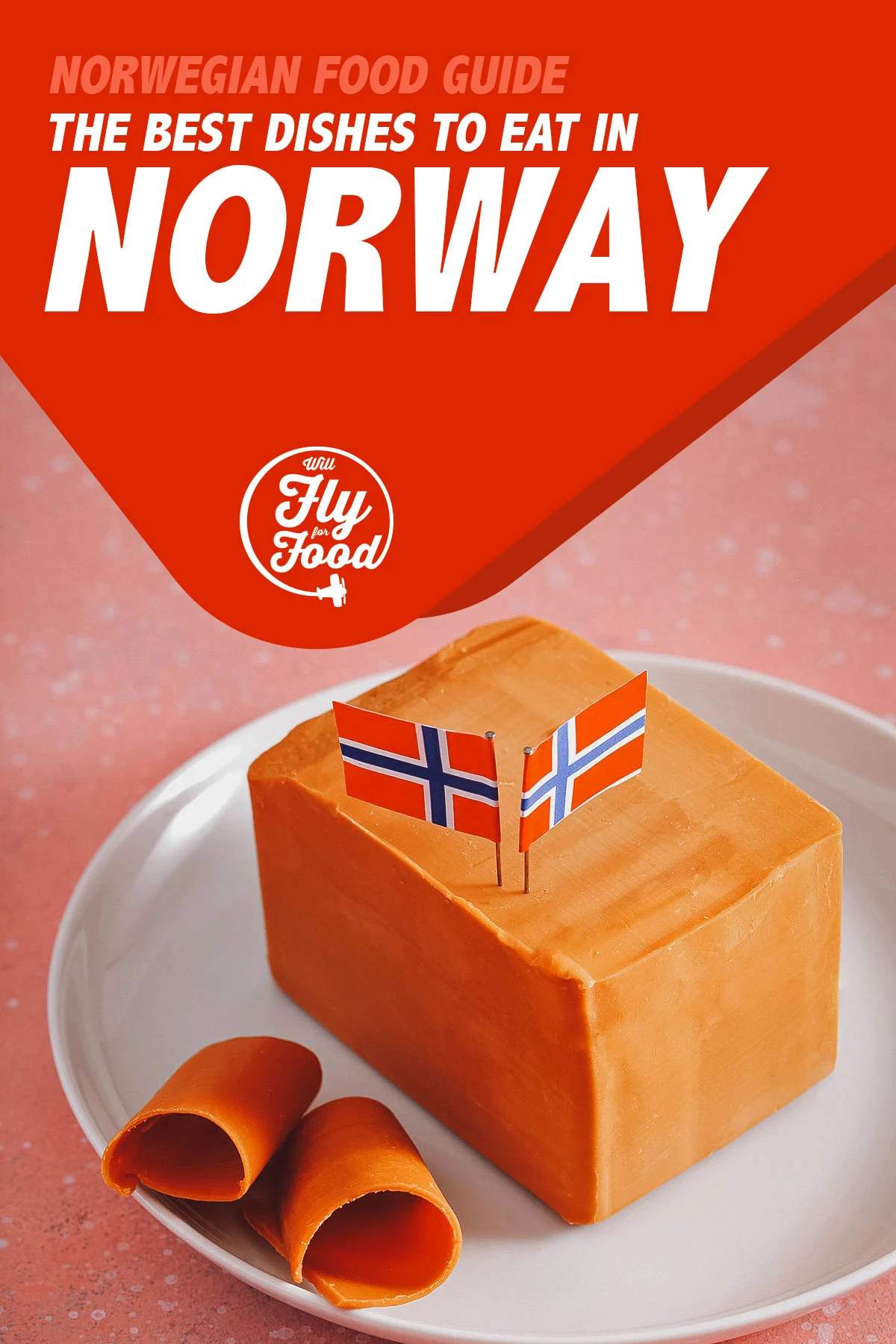
Photo by duskbabe
WHAT IS TRADITIONAL NORWEGIAN FOOD?
Traditional Norwegian cuisine is largely a reflection of its environment. Norway is home to one of the world’s longest coastlines so it’s only natural for fish to play a significant role in Norwegian cuisine and culture. For centuries, dried cod was the biggest Norwegian export. Today, it’s fresh salmon and Atlantic cod.
In many ways, traditional food in Norway is different from most of continental Europe. It puts a stronger emphasis on fish and game. Reindeer, moose, deer, and grouse are popular game meats that are just as often served at Norwegian restaurants as they are at home.
Lamb also figures prominently in the Norwegian diet. Fårikål is the Norwegian national dish while Fenalår, a dish of slow-cured lamb’s leg, has been given Protected Geographical Indication (PGI) status. Because of its long winters, preserving food like cod and lamb wasn’t done just for pleasure in Norway, it was a necessity.
Interestingly, Norway’s most famous cheese – brunost – isn’t a cheese at all. It’s brown in color and often enjoyed with Norway’s most beloved snack – Norwegian waffles shaped like hearts.
MUST-TRY NORWEGIAN FOOD
A list of 25 Norwegian dishes can be a mouthful. To make it easier to digest, this Norwegian food guide has been organized by category. Click on a link to jump to any section of the guide.
NORWEGIAN DAIRY PRODUCTS
1. Brunost
There’s no better way to start this Norwegian food guide than with brunost, one of the most recognizable dishes in Norwegian cuisine. It’s the Norwegian name for mysost – a family of Scandinavian brown cheeses that’s become well-known for its unique color and fudge-like texture. The name brunost literally means “brown cheese” in Norwegian although technically, it isn’t a cheese at all.
Norwegian brunost is made from whey which is a by-product of the cheese-making process. To make it, a mixture of milk, cream, and whey is boiled for several hours until the water evaporates and the milk sugars turn into caramel. This is what gives brunost its characteristic brown color and sweetness. The longer the whey mixture is boiled, the browner this Norwegian “cheese” becomes. This caramelized sugar is then allowed to cool before being packaged and sold in blocks.
Brunost can be made with cow’s milk, goat’s milk, or a combination of the two. It’s sweet and caramel-like but versions made with goat milk have a sharper and tangier flavor. Cut with a cheese slicer, Norwegian brunost is typically eaten with bread, crackers, or Norwegian waffles, and it can also be used as an ingredient in savory Norwegian dishes like finnbiff.
There are many types of Norwegian brunost, most of which are produced by the dairy co-operative Tine. By far, the most popular brand is Gudbrandsdalsost. It’s made with goat’s and cow’s milk and is often touted as the “original brunost”. Fløtemysost, a version made without goat milk, is also popular among Norwegians who prefer a milder flavor.
Both versions were invented by a Norwegian milkmaid from Gudbrandsdalen named Anne Hov (more on that below).
RECIPE: Gingercake with brunost
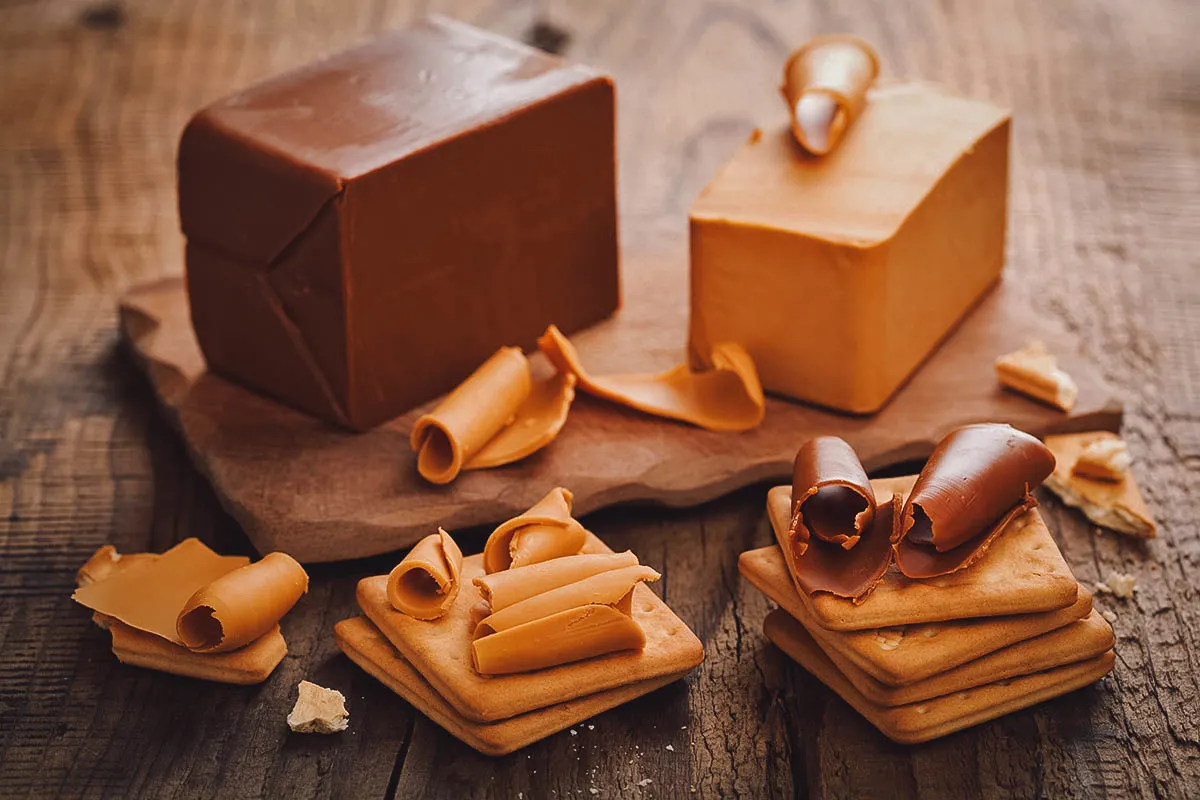
Photo by duskbabe
Although brunost is a Norwegian dish, brown whey cheese or mysost has been consumed in Scandinavia for centuries and goes by different names like mesost (Sweden), myseost (Denmark), mesjuusto (Finland), and mysuostur (Iceland).
Whey had been traditionally boiled down to create a soft cheesy spread but it was Anne Hov who had the idea of mixing in cream and boiling it further to create a more solid product. This came to be known as fløtemysost. She would later add goat’s milk to create Gudbrandsdalsost.
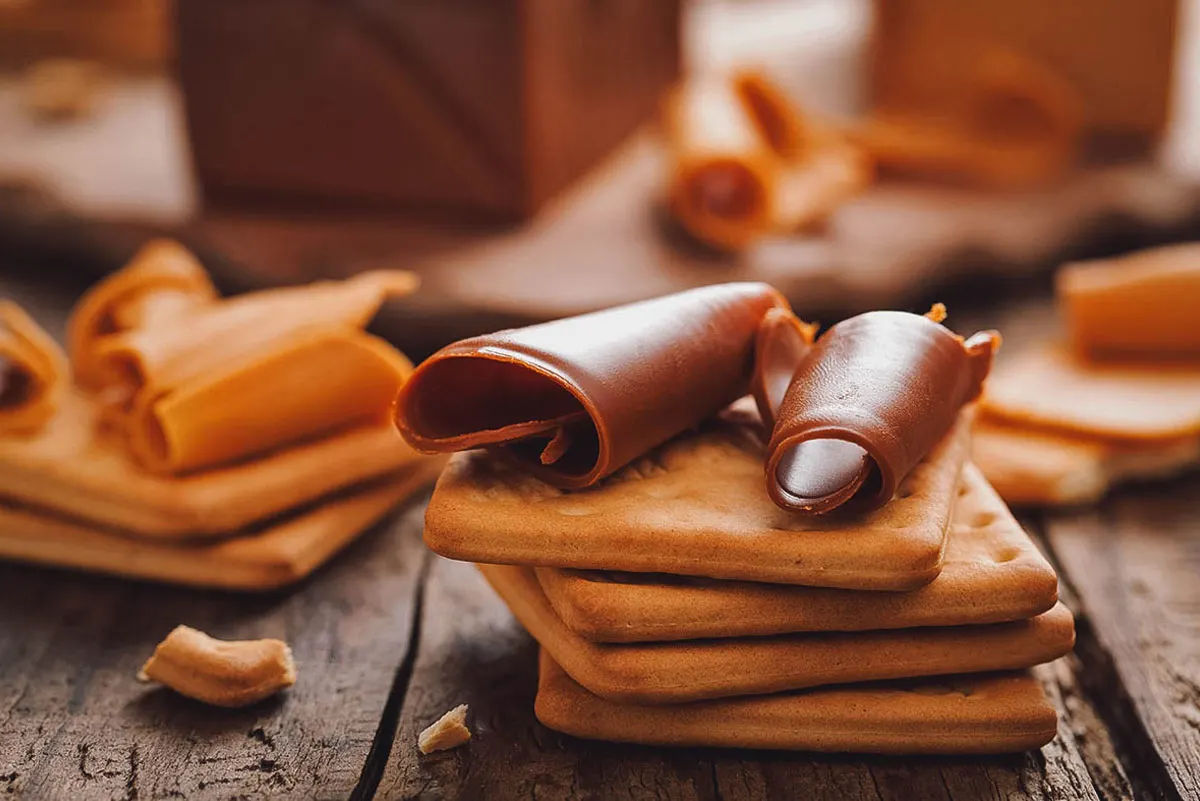
Photo by duskbabe
2. Rømmegrøt
Fans of traditional food will surely enjoy rømmegrøt, a classic Norwegian sour cream porridge made with whole milk, wheat flour, sour cream, butter, cinnamon, sugar, and salt. It’s a rich and sweet Norwegian dish that’s often enjoyed with cured meat or as a simple meal with crackers and a glass of milk. Rømme in Norwegian means “sour cream” while grøt means “porridge”.
Because it’s so thick and filling, Norwegian rømmegrøt is usually consumed in small quantities. It’s typically reserved for Norwegian holidays or special occasions, often with a side of Norwegian cured meats like fenalår (cured leg of lamb).
RECIPE: Rommergrot
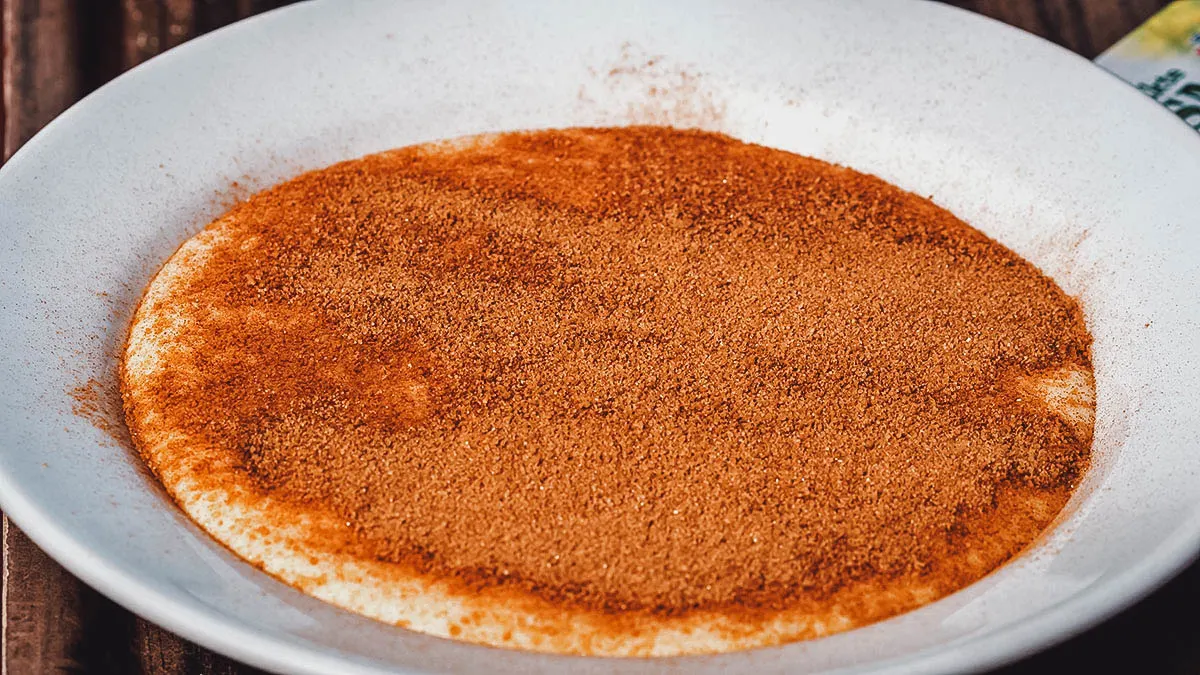
Photo by asmus
NORWEGIAN SEAFOOD
3. Sursild (Pickled Herring)
Sursild refers to a traditional food of Norwegian pickled herring. It consists of salted herring slices, onions, and various spices like black peppercorns, allspice, cloves, and mustard seeds kept in a jar with a pickling liquid made from water, vinegar, and sugar.
Norwegian pickled herring can be enjoyed throughout the year though it’s traditionally a Christmas season dish in Norway. It can be consumed in different ways – as open-faced sandwiches for a traditional Norwegian breakfast, as hors-d’oeuvres, or as part of heavier meals with potatoes and sour cream.
RECIPE: Norwegian pickled herring
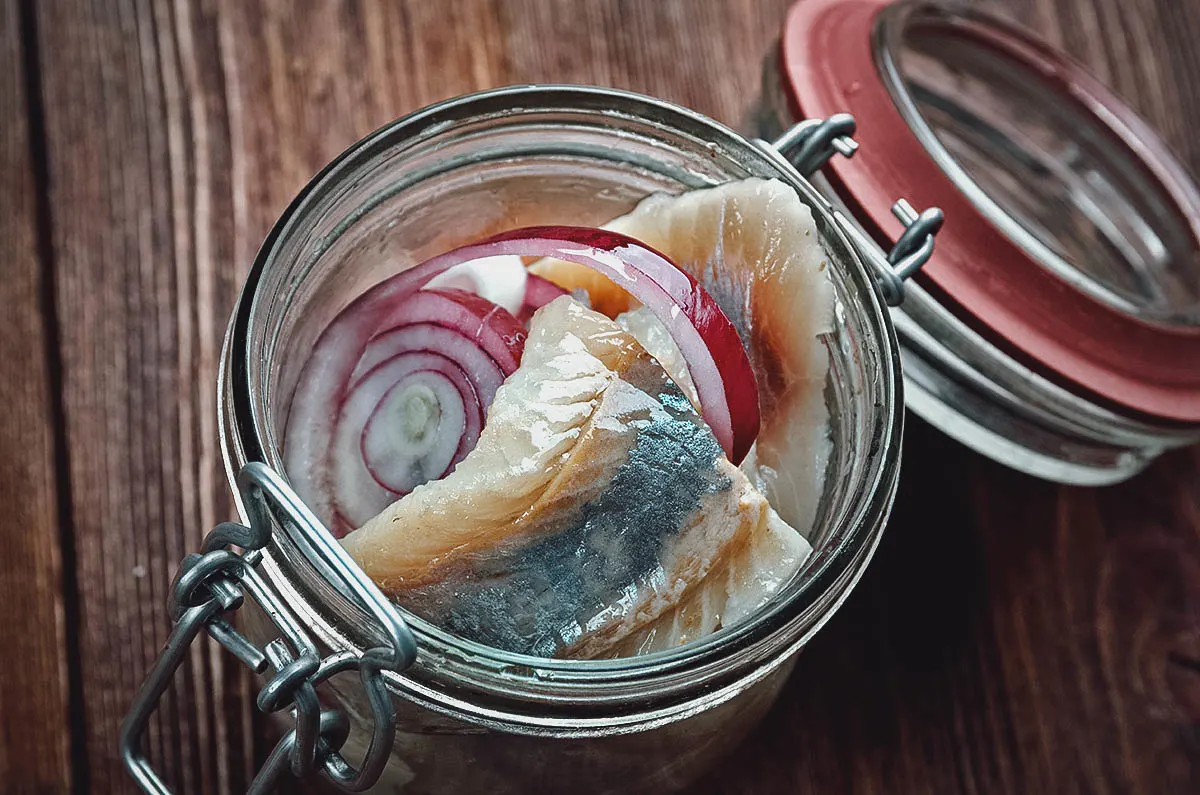
Photo by fanfon
4. Tørrfisk fra Lofoten
When it comes to the traditional food in Norway, tørrfisk fra lofoten should always be part of the discussion. It refers to Norwegian stockfish made from air-dried cod. Atlantic cod are fished from the waters of Lofoten and Vesterålen and then left to dry naturally on wooden racks called hjell from February till May.
Norwegians have been air-drying and preserving cod in this manner for centuries. Thanks to the North Atlantic Current, winters in Lofoten are relatively mild making it an ideal place to produce stockfish. The cod can be dried by the cold Norwegian air and wind without freezing or decomposing.
After air-drying for three months, the cod are matured indoors for another 2-3 months. About 80% of the water in the fish evaporates during this process. This concentrates the nutrients in the fish making it an even richer source of protein, vitamins, iron, and calcium.
Most tørrfisk is exported to Italy, Croatia, and Nigeria. In Norway, it’s consumed mostly as a snack or used in Norwegian dishes like lutefisk.
RECIPE: Torrfisk
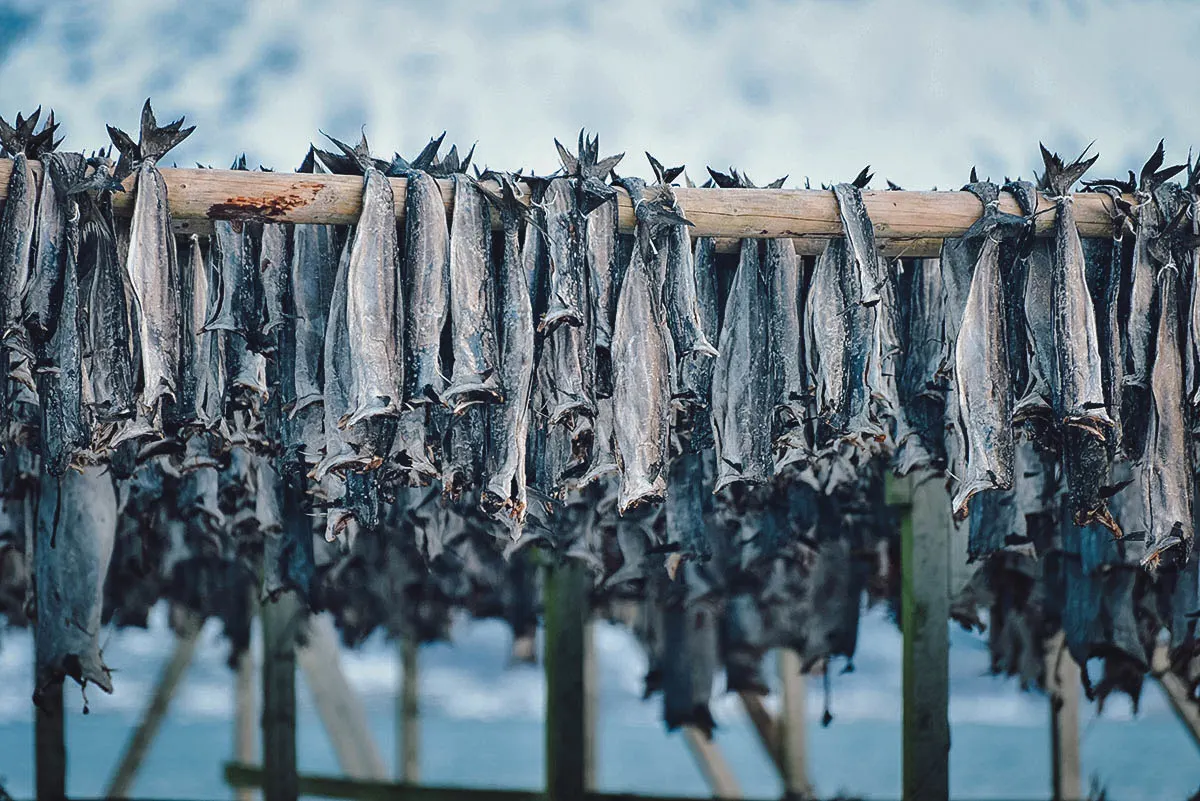
Photo by demerzel21
5. Lutefisk
Lutefisk is a traditional dish popular in Norway, Sweden (lutfisk), and parts of Finland (lipeäkala). One of the stranger Norwegian foods on this list, it refers to a gelatinous fish dish made from tørrfisk pickled in lye. Lut in Norwegian means “preserved in lye” while fisk means “codfish”.
Lutefisk is prepared by rehydrating tørrfisk in water for several days before soaking it further in a water and lye solution. As it soaks, the fish swells and loses over half of its protein content, producing a jelly-like consistency. It’s then soaked for a few more days in water before it’s cooked – either by steaming, baking, boiling, or even microwaving.
In Norway, lutefisk is often served with boiled potatoes, mashed green peas, melted butter, and bits of fried bacon. It’s considered a winter dish that’s typically consumed around the Christmas season. Because of its gelatinous texture, it seems to be a dish that non-Norwegian people either love or hate.
Thanks to its polarizing nature and popularity among Norwegian-Americans, lutefisk has become one of the most internationally well-known Norwegian dishes. In fact, far more lutefisk is consumed in the US than in all of Scandinavia! It’s so popular in parts of North America that Madison City in Minnesota has declared itself to be the “lutefisk capital of the USA“.
RECIPE: Lutefisk
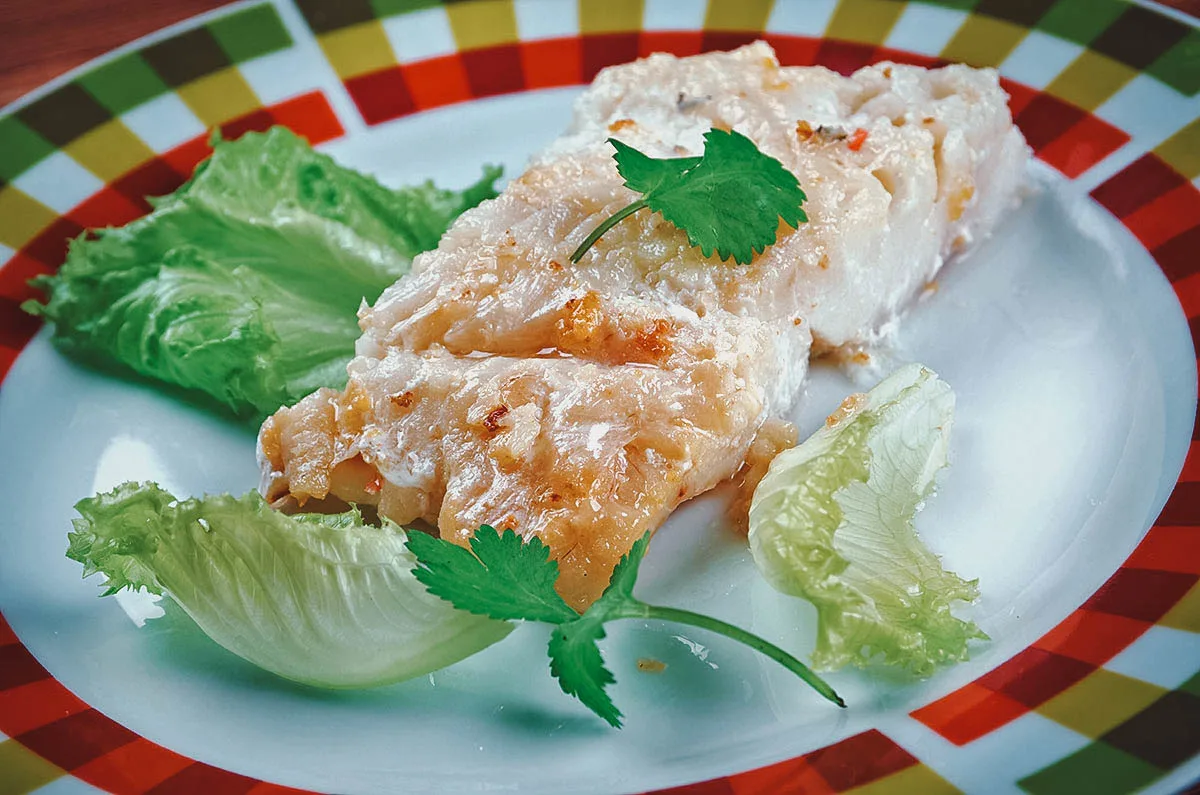
Photo by fanfon
6. Smoked Salmon
Smoked salmon is one of the most internationally famous Norwegian dishes. It’s one of Norway’s biggest exports and arguably the greatest Scandinavian contribution to international cuisine. Norwegian salmon has a higher fat content than any other salmon in the world – about 18% – making it perfectly suited for smoking.
Norwegian smoked salmon is made by hand-salting fillets with a small amount of sugar added. It’s then cured in a brine before being cold-smoked with beechwood for 3-4 hours at 68°F (20°C). This cold-smoking process is said to produce a smoked salmon that’s less salty than its counterparts.
Salmon in Norway is typically consumed simply – dusted with ground black pepper and served on rye bread.
RECIPE: Norwegian smoked salmon roll-ups
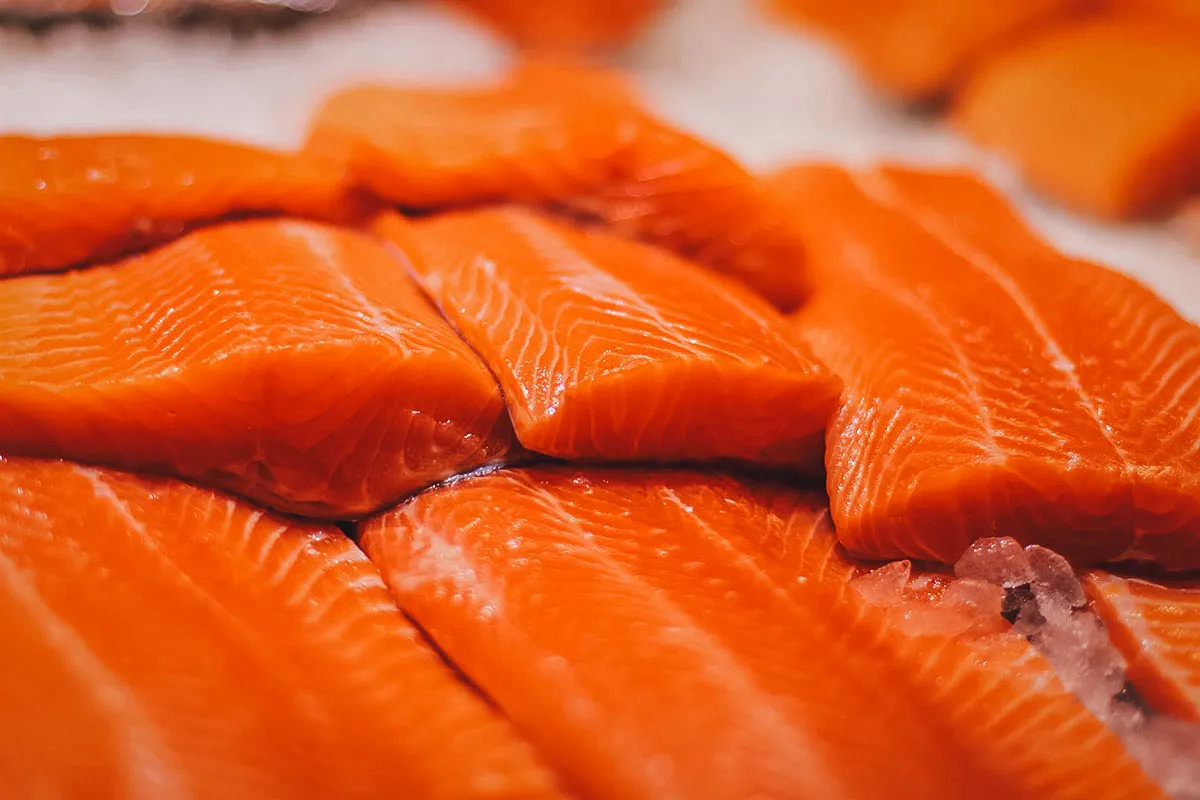
Photo by Jastock
Gravlaks is another popular salmon dish in Norway. It refers to Norwegian salmon that’s been cured using salt, sugar, and dill. It’s typically eaten as an appetizer with a mustard and dill sauce called sennepssaus, either on bread or with boiled potatoes.
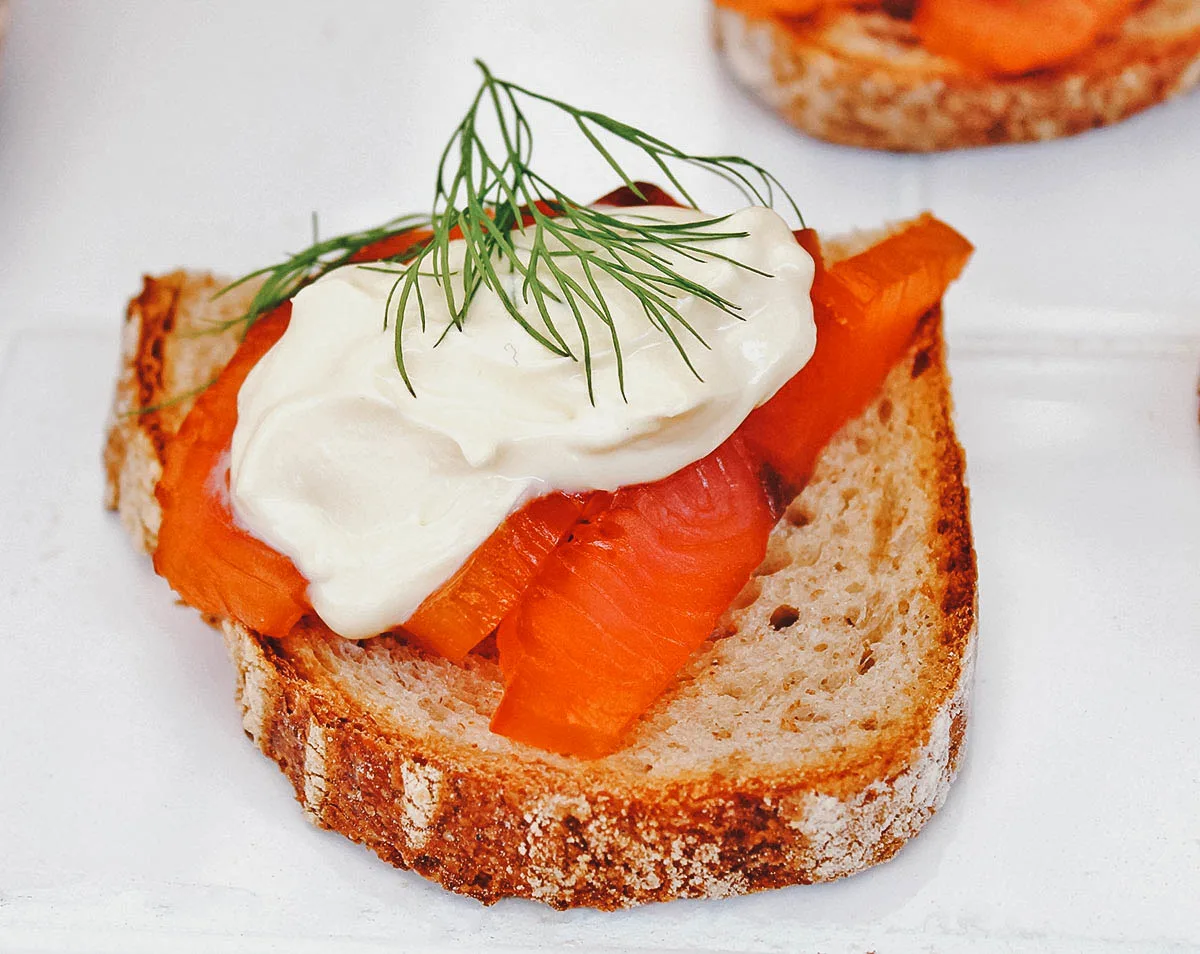
Photo by cheekylorns2
7. Fiskeboller
Fiskeboller refers to Norwegian fish balls. Fish balls are a staple food in Norway and can be found in almost every Norwegian household.
Norwegian fish balls have a silky texture and a mild, almost bland flavor. They can be used in various Norwegian soups and stews but they’re most often served in a creamy white sauce with boiled potatoes and vegetables like asparagus, broccoli, cauliflower, and carrots. Sometimes, a mild curry is used to give the fish balls more flavor.
In Norwegian supermarkets, fiskeboller is readily available in cans but like any fish ball, the best versions are made from scratch. Norwegian fish balls are typically made using flour, milk, eggs, and minced whitefish like cod, haddock, or pollock.
RECIPE: Norwegian fish balls in white sauce
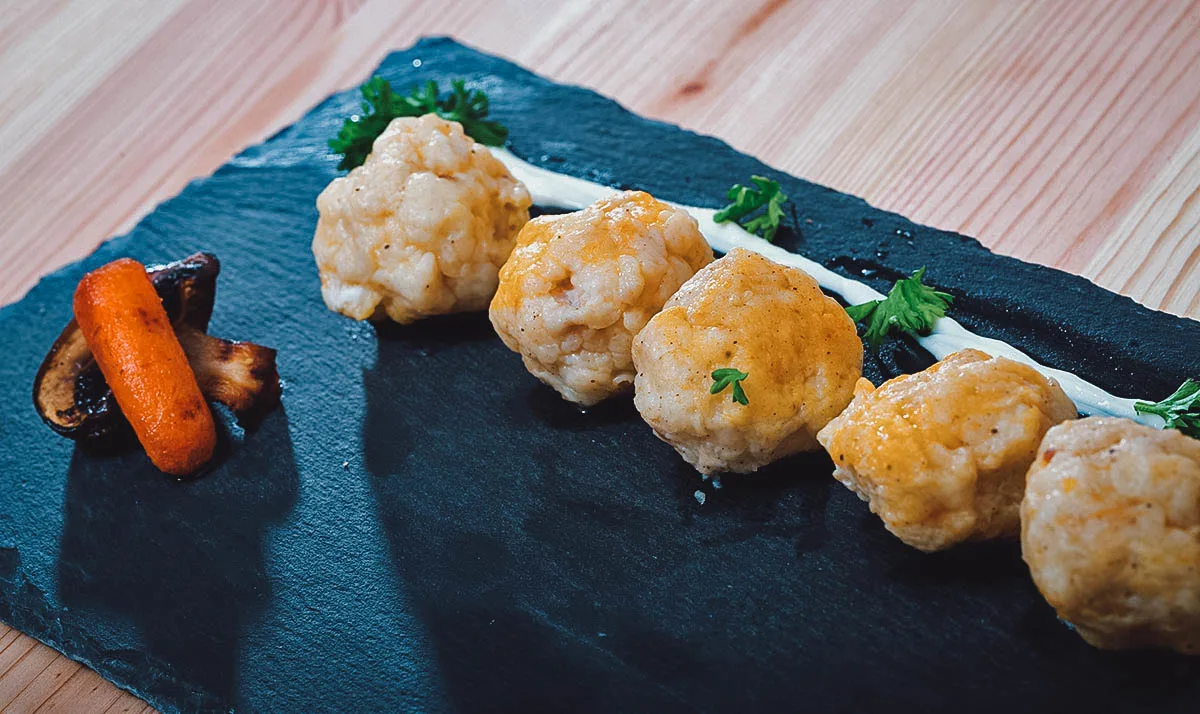
Photo by Jim_Filim
8. Fiskesuppe
Fiskesuppe refers to a creamy Norwegian soup made with fresh fish, shellfish, root vegetables, and fresh herbs. It’s consumed in different variations throughout Norway but common ingredients include cod, Norwegian salmon, prawns, carrots, celeriac, milk, butter, and cream.
Like many western soups, fiskesuppe is typically eaten as a starter with a side of Norwegian crusty bread.
RECIPE: Fiskesuppe
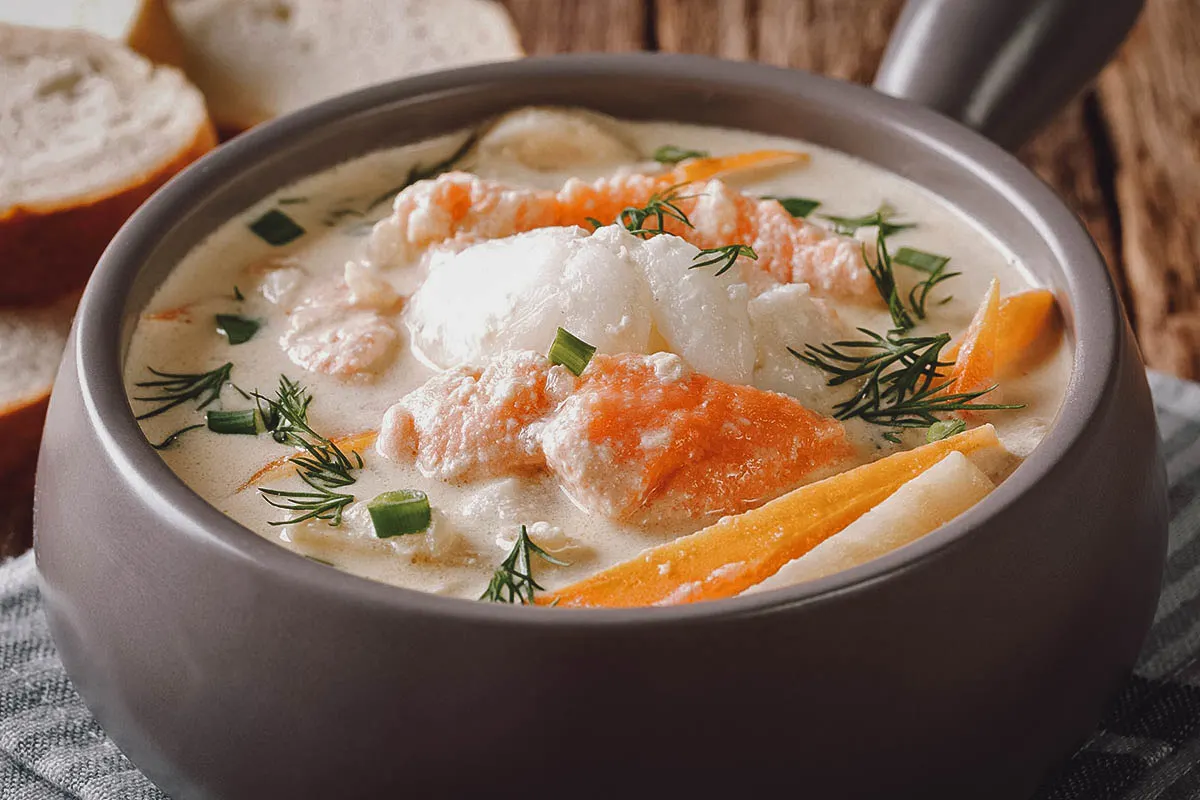
Photo by lenyvavsha
NORWEGIAN MEAT DISHES
9. Fårikål (Norwegian National Dish)
No article on Norwegian food can ever be complete without mentioning fårikål. Fårikål is widely considered to be the national dish of Norway. It’s a simple but hearty Norwegian dish made with lamb, cabbage, and potatoes.
Fårikål is a seasonal Norwegian dish that’s traditionally consumed during Norway’s colder months, starting in September, to welcome autumn. To prepare, bone-in lamb or mutton is slow-cooked in a casserole with cabbage, whole black pepper, salt, and water. Flour can sometimes be added to thicken the broth. When ready, it’s served with boiled potatoes.
According to a popular Norwegian food blogger, fårikål is a favorite dish to prepare when having guests over for dinner, usually on Sundays.
RECIPE: Farikal
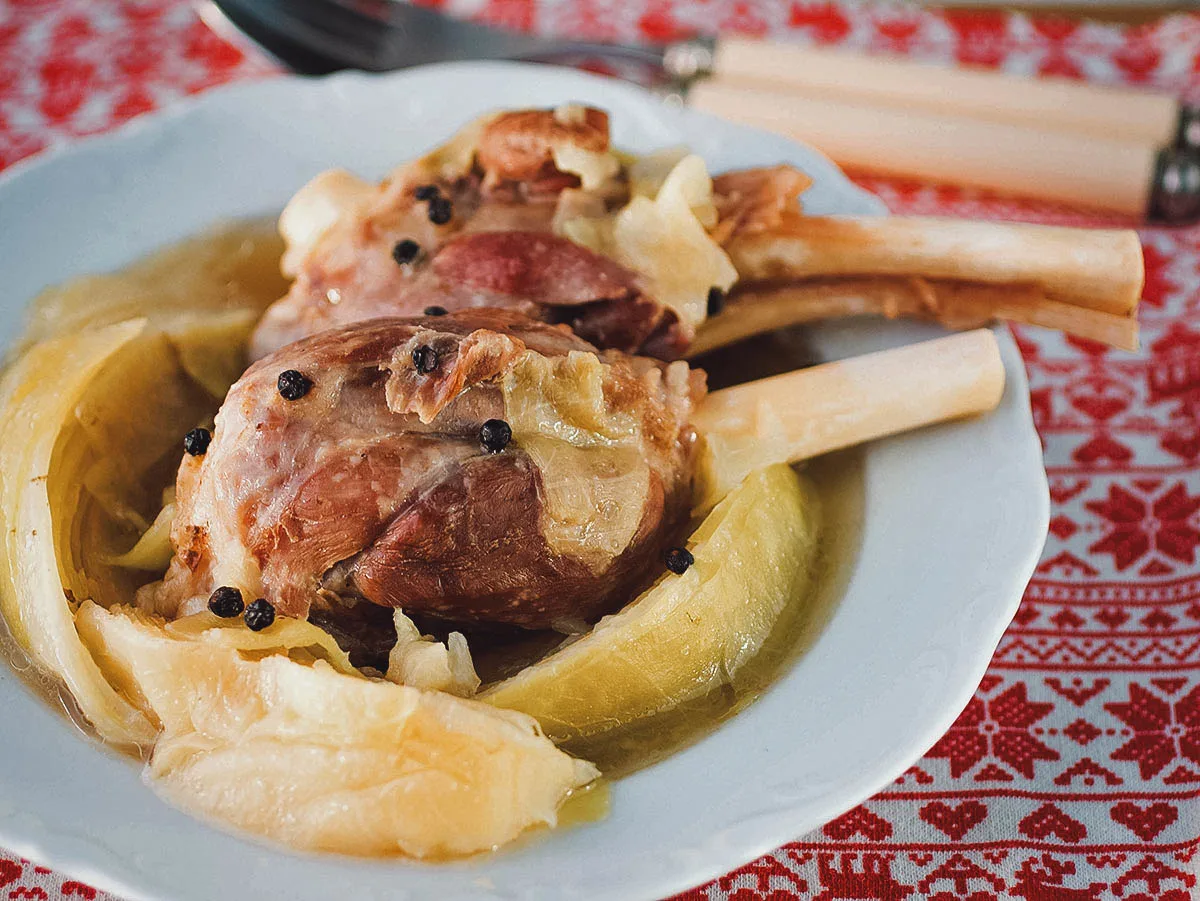
Photo by La_vanda
10. Pinnekjøtt
Pinnekjøtt is a traditional Norwegian Christmas dish of steamed lamb ribs paired with pureed rutabaga and boiled potatoes. It’s often served with beer and akevitt, which is a type of Nordic distilled spirit derived from grain and potatoes. Pinnekjøtt is traditionally associated with the western regions of Norway though it’s become more common in other parts of the country as well.
Pinnekjøtt takes weeks of preparation. The first step is to cure racks of lamb or mutton in brine or coarse sea salt. In some parts of Norway, they’re smoked prior to curing to prevent the growth of mold during the drying process. They’re then hung to dry in a cool dark space for about 6-8 weeks.
When ready, the rack is soaked in water for about 9-10 hours to rinse out the salt and reconstitute the meat. The ribs are then steamed over a layer of birch branches for 2-3 hours until the meat is fall-off-the-bone tender. The name pinnekjøtt literally means “stick meat”, likely in reference to this layer of birch twigs used for steaming. For even more flavor, Norwegian cooks often broil the ribs before serving.
RECIPE: Pinnekjott
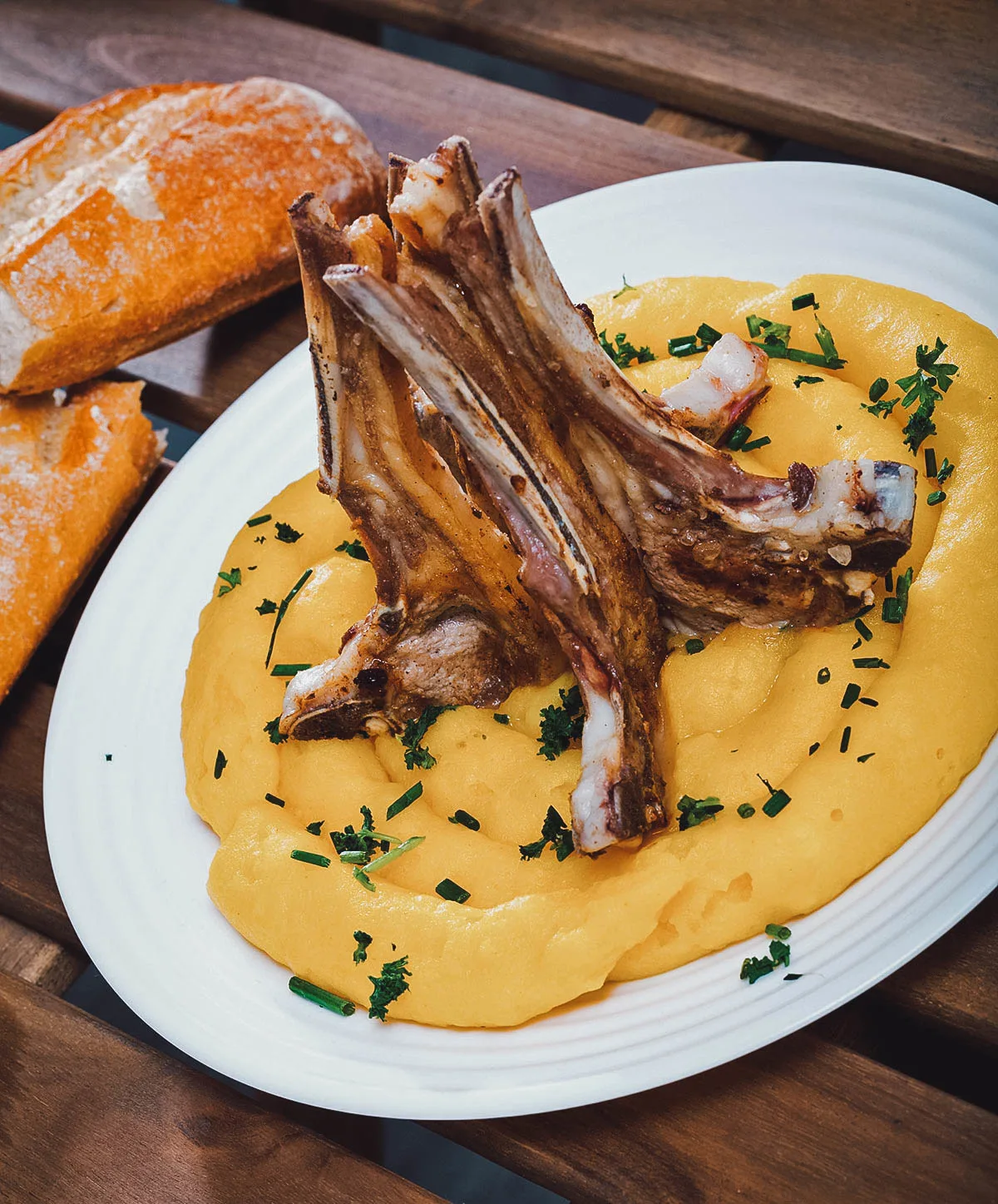
Photo by Jim_Filim
11. Lapskaus
Lapskaus refers to a thick Norwegian stew made with different types of meat, vegetables, and potatoes. It’s a rich and filling stew that may be derived from lobscouse – a similarly chunky Northern European sailor’s stew associated with the city of Liverpool.
Norwegian lapskaus can be made with fresh or leftover meat, usually beef or lamb though chicken or pork may be used as well. Common vegetables include carrots, onions, rutabaga, celery root, and leeks. It’s seasoned simply with just salt and pepper and eaten with Norwegian flatbrød (flatbread).
RECIPE: Lapskaus
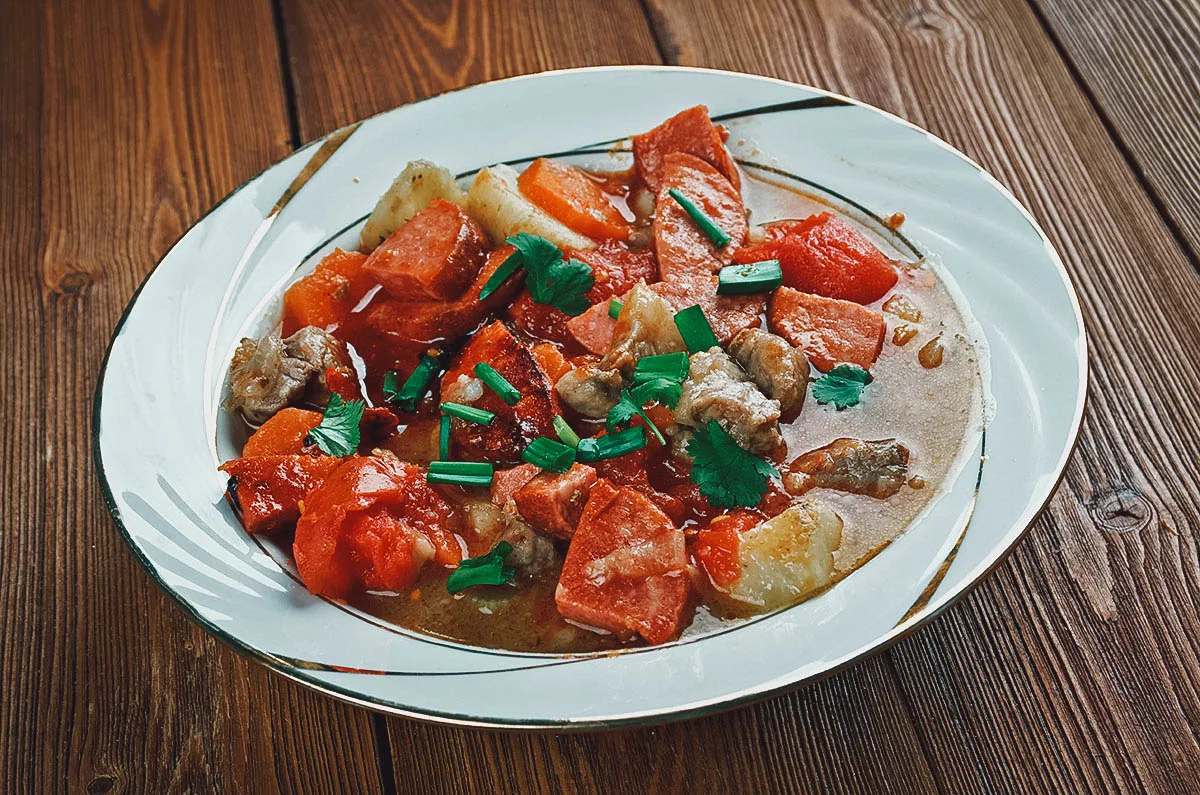
Photo by fanfon
12. Kjøttboller / Kjøttkaker
Kjøttboller and kjøttkaker refer to traditional Norwegian meatballs. It’s similar to the more famous Swedish meatball though the Norwegian version is generally larger.
Recipes for Norwegian meatballs vary but most are made with some combination of ground beef and ground pork with a host of seasonings like salt, black pepper, sugar, nutmeg, ginger, and allspice. They’re typically pan-fried and served with a brown sauce, kålstuing (cabbage in cream sauce), lingonberry jam, and potatoes.
Kjøttboller and kjøttkaker are essentially the same thing. They both refer to Norwegian meatballs with the only difference being their shape. Kjøttboller are round like typical meatballs while kjøttkaker are flatter, like patties, and more oval in shape.
RECIPE: Kjottkaker med brunost
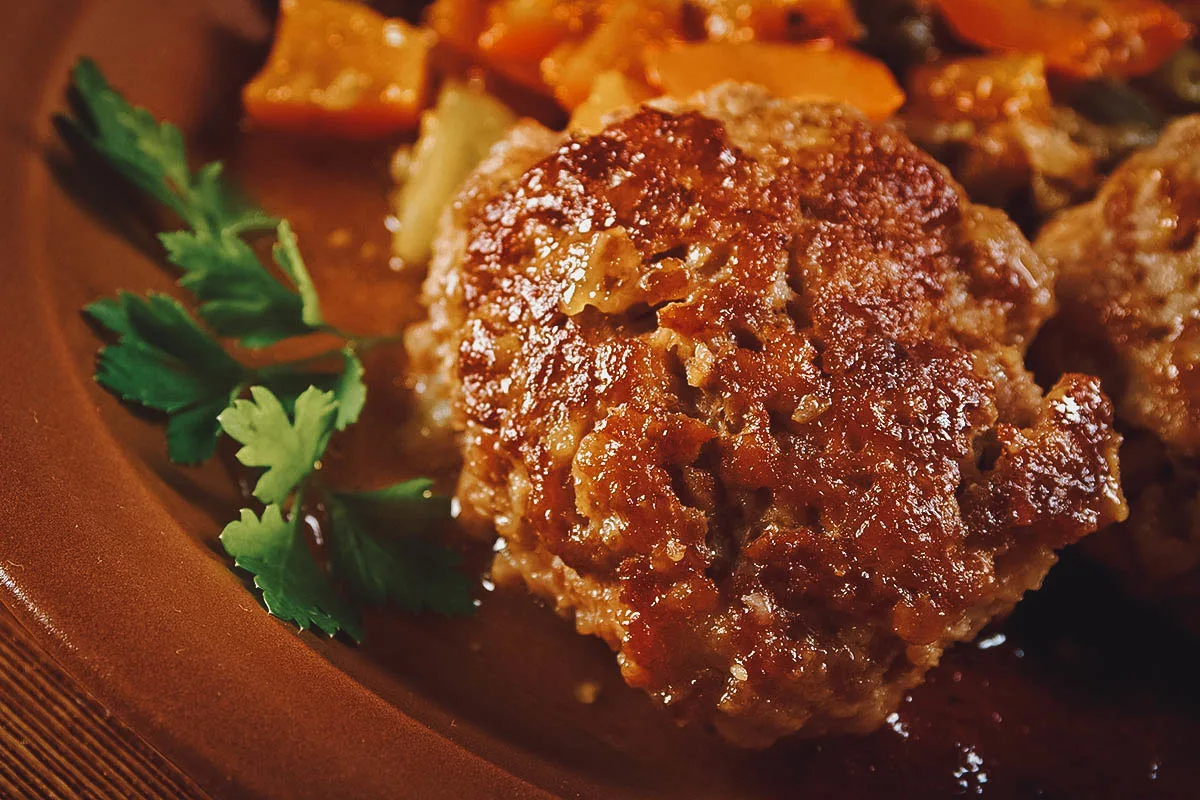
Photo by fanfon
13. Finnbiff
Finnbiff is one of the more interesting Norwegian foods on this list. It refers to a type of Norwegian stew made with reindeer. Game meats are common in Norway and finnbiff is the most widely consumed dish made with reindeer meat. It’s common in the northern parts of Norway and the Sápmi (Lapland) regions of Sweden and Finland.
To prepare, thin reindeer shavings are browned in a pot with bacon and mushrooms. Water is then added to create a broth followed by crushed juniper berries, brunost (brown cheese), thyme, sour cream, and milk. This creates a rich, caramel-y, and earthy Norwegian stew that’s best enjoyed in autumn and winter, usually with side dishes like mashed potatoes and green vegetables.
RECIPE: Finnbiff
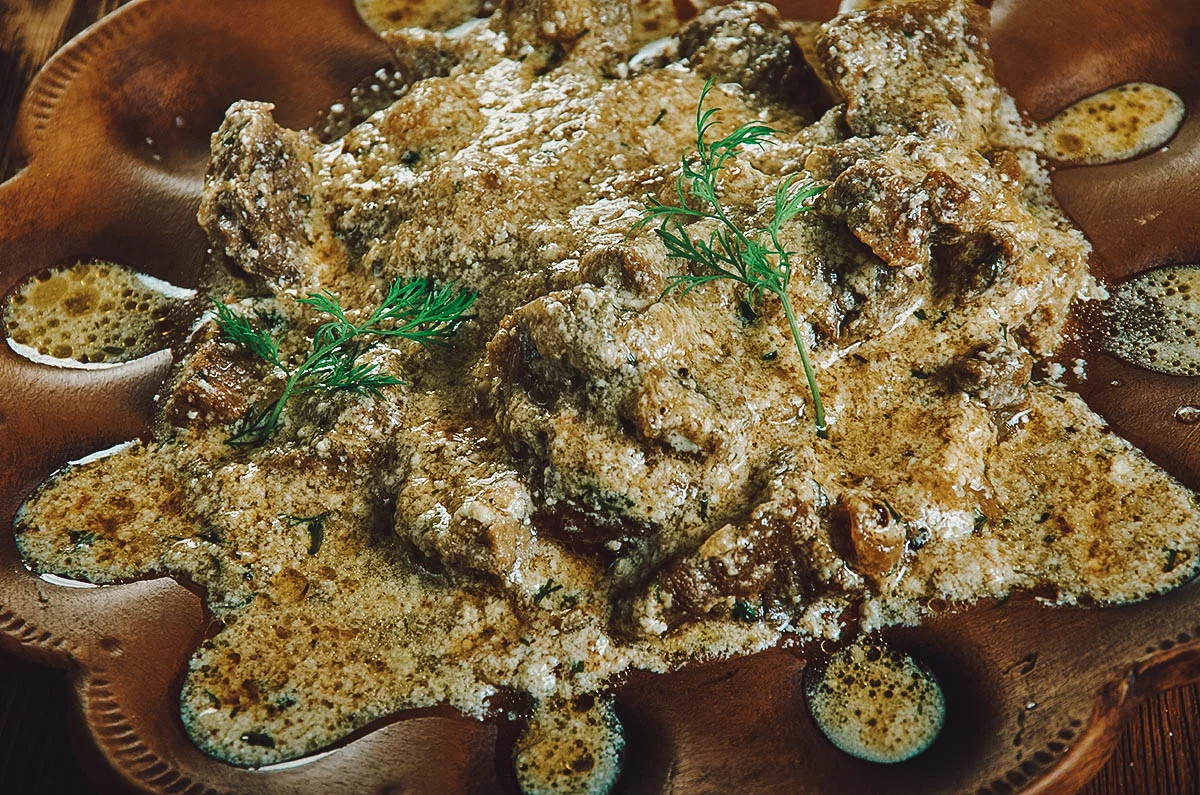
Photo by fanfon
14. Bidos
Bidos refers to another type of Norwegian stew made with reindeer meat. It’s native to the Sámi people, an indigenous reindeer-herding people living in the Sápmi regions of Norway, Sweden, Finland, and Russia.
Norwegian bidos consists of reindeer meat (including the heart) that’s slow-cooked with onions, potatoes, and carrots. It’s seasoned simply with just salt, pepper, and perhaps some mustard to showcase the natural flavors of the reindeer meat. It’s a special Norwegian dish that’s typically reserved for Sámi weddings and other celebratory occasions.
RECIPE: Bidos
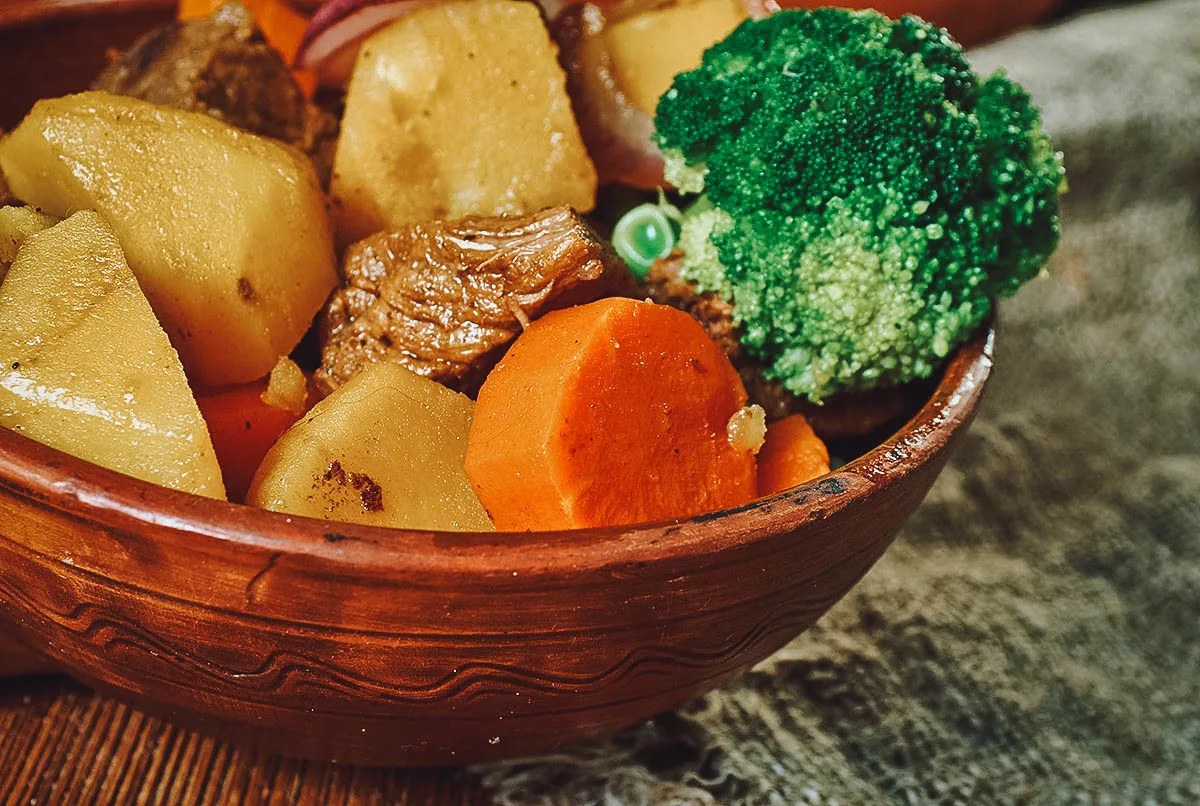
Photo by fanfon
15. Whale Steak
This next dish may be one of the more controversial Norwegian foods on this list, at least for non-locals.
Whale hunting has been a part of Norwegian culture for centuries. In the early 20th century, meat from minke whales was used as a cheap substitute for beef. Together with Japan and Iceland, Norway is one of just three countries that continues to publicly allow commercial whaling.
Commercial whaling has been a contentious subject for decades but in Norway, eating whale meat isn’t considered controversial. It doesn’t form a significant part of the Norwegian diet though it remains a popular source of meat in some parts of Norway.
Over the years, the consumption of whale meat has been on a steady decline though it’s still widely available throughout Norway and consumed from time to time by most Norwegians.
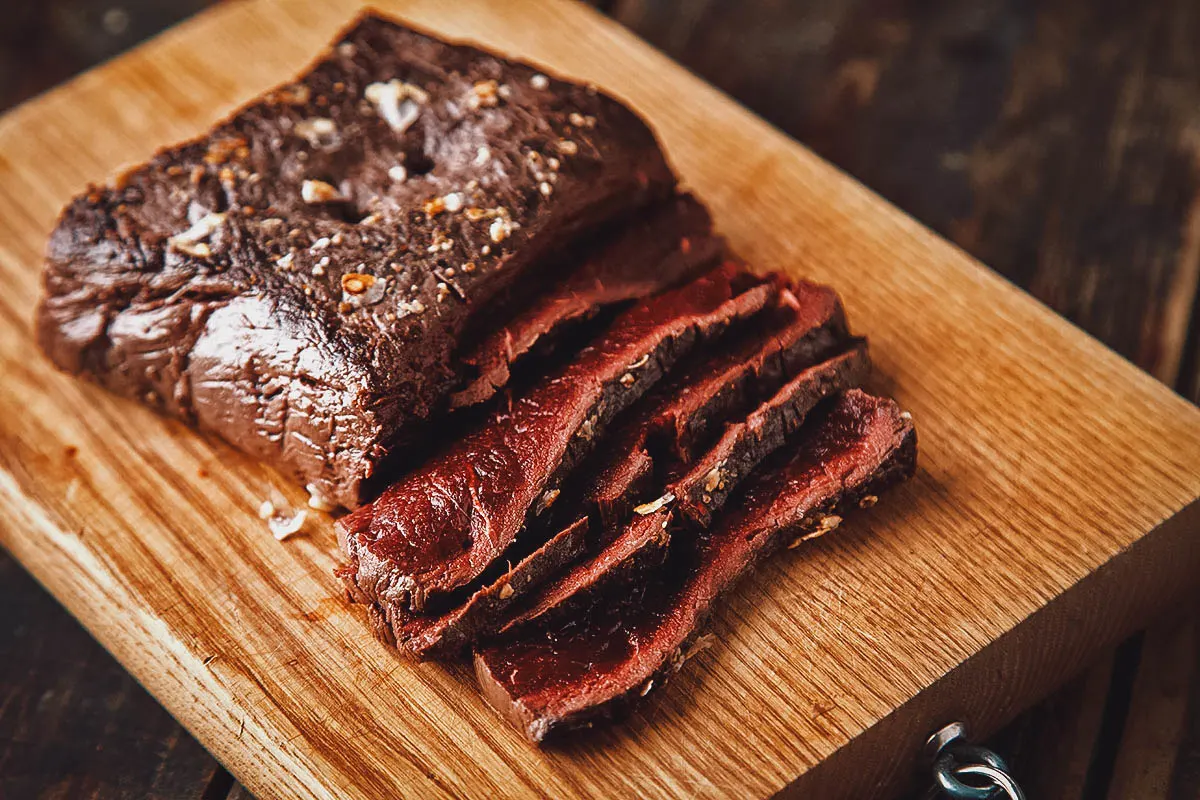
Photo by derepente
NORWEGIAN BREADS / NORWEGIAN DESSERTS
16. Lefse
Lefse refers to a traditional Norwegian soft flatbrød (flatbread) that’s a staple food in Norway. Similar to a tortilla, it can be prepared and enjoyed in many different ways – thick or thin, big or small, plain or filled with sweet and savory ingredients.
Norwegian recipes for lefse vary depending on where it’s from, but it’s traditionally made with a base of whole wheat flour, milk, butter, water, and salt. Versions made with potato became popular after the tubers were introduced to Norway sometime in the mid-18th century.
In the past, Norwegian households would make enough lefse to last them through the winter. They’d store them in a dehydrated state and soften them with water when ready to eat.
To make lefse, the dough is flattened using a special grooved rolling pin designed to remove air pockets. It’s then cooked on a large, flat griddle using a long wooden turning stick. When cooked, the lefse is cut into smaller pieces and served with butter and other ingredients like sugar, cinnamon, brunost (brown cheese), or lingonberry jam. It can be used as a wrap for savory ingredients as well like beef or lutefisk.
RECIPE: Lefse
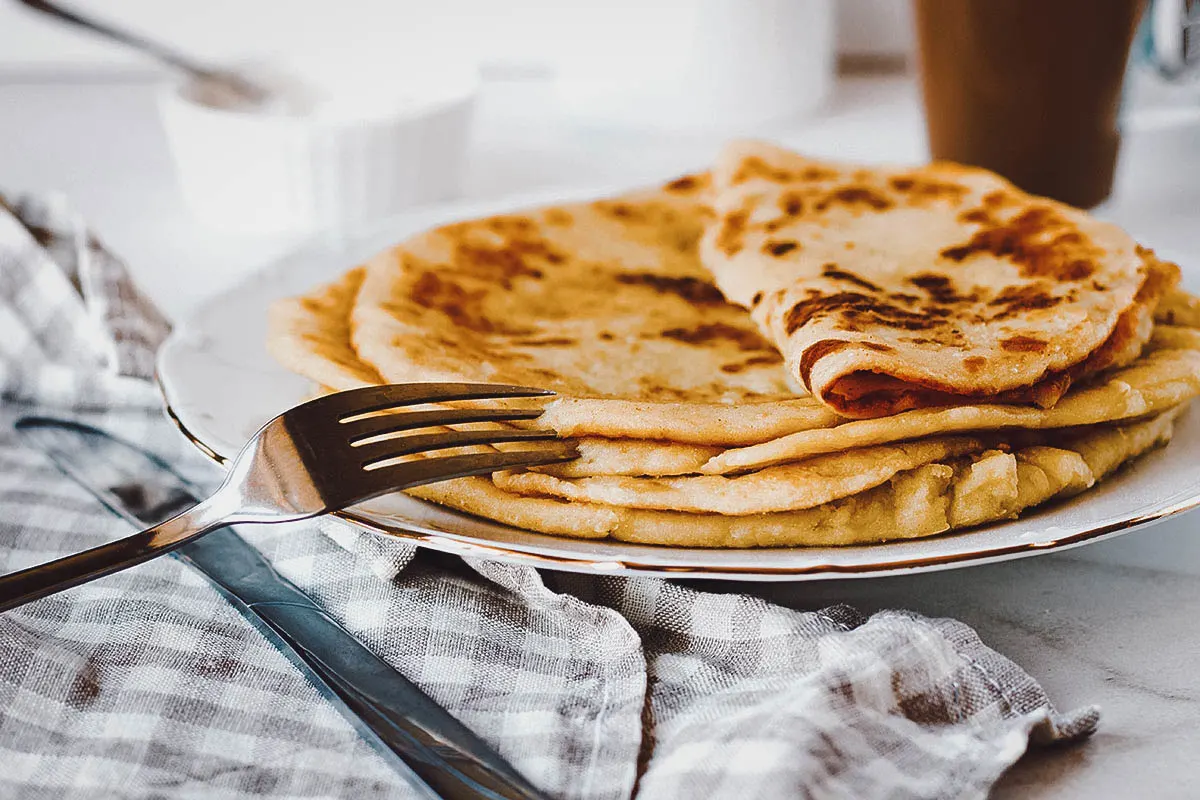
Photo by Natalikomp
There are many types of lefse from different regions in Norway. Some of the most popular include potetlefse (made with potatoes), møsbrømlefse (made with brunost brown cheese), tykklefse (thicker and more cake-like), and kjøttlefse (made with meat, like a taco).
Pictured below is pølse med lompe. It’s a Norwegian dish made with lomper, another type of potato lefse that’s often used in place of a bun when serving hot dogs.
It’s interesting to note that lefse is a popular Norwegian dish in parts of the US as well. Thousands of Norwegians migrated to America in the mid-19th century and brought with them their recipes for lefse. They settled throughout the US, with the largest populations located in the Midwest, California, Oregon, and Washington.
Unlike in Norway, Norwegian-American lefse is always made with potatoes. It’s considered a holiday dish that’s typically eaten around Christmas and Thanksgiving.
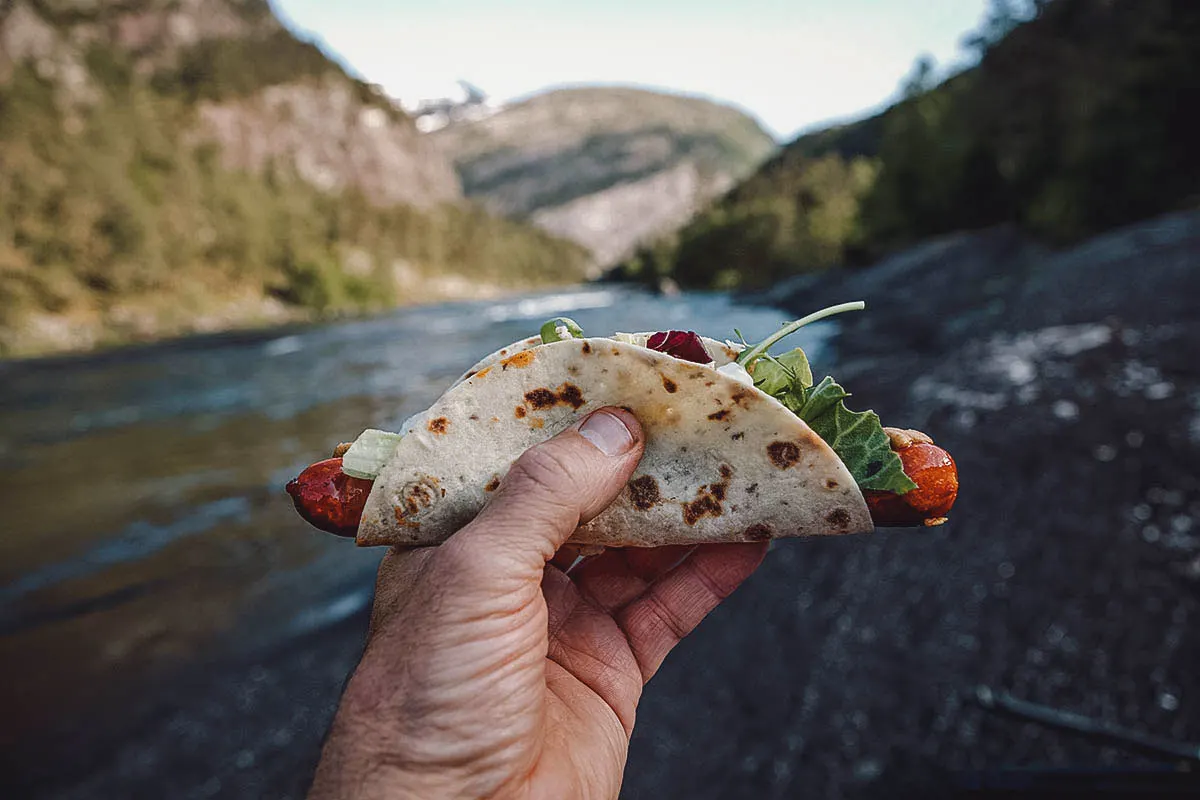
Photo by Tobben63
17. Vafler
Vafler means “waffles” and refer to these beloved heart-shaped Norwegian treats. They’re available everywhere – at cafes, restaurants, sporting events, and homes – and are considered the quintessential snack food in Norway.
Unlike American waffles that are typically eaten for breakfast, Norwegian waffles can be enjoyed throughout the day. They’re thinner and softer than American or Belgian waffles and topped with a variety of ingredients like whipped cream, sour cream, brunost (brown cheese), gomme (sweet cheese), berries, jam, and sugar. Sweet toppings are the most common but they can be paired with savory ingredients as well like blue cheese, sausage, or eggs.
In Norway, the word kos is used to represent “coziness” or “having a good time”. It’s essentially the Norwegian version of the Danish concept of hygge. It can mean many different things to Norwegians but at its core, it’s meant to describe the type of instant happiness you get when you feel safe, warm, and connected. The Norwegian waffle is the quintessential symbol of kos.
RECIPE: Vafler
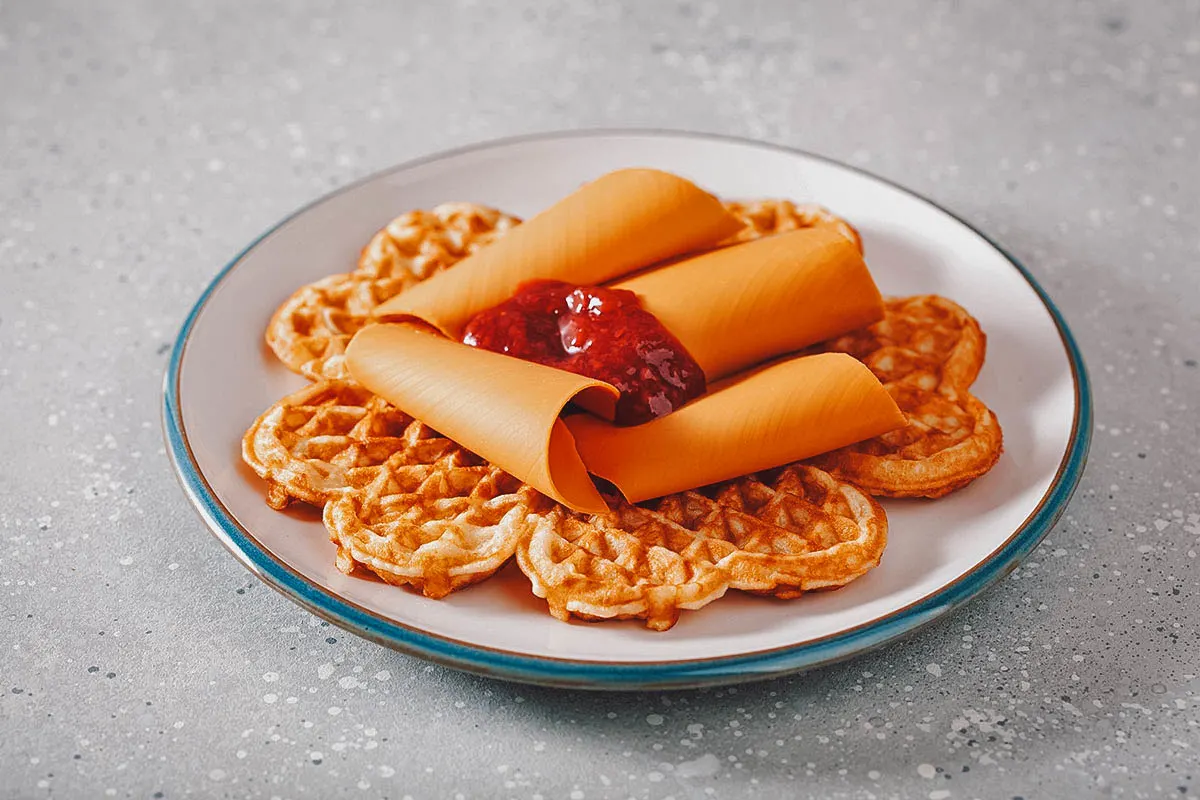
Photo by duskbabe
18. Eplepai
Eplepai refers to a traditional Norwegian apple pie. In spite of its name, it more closely resembles a cake than a pie, made with diced apples that are stirred directly into the batter. When Norwegians make American-style apple pie, they call it Amerikansk eplepai.
When searching for recipes for Norwegian eplepai, you’ll come across recipes for similar-looking dishes called eplekake or apple cake. The similarity between recipes seems to indicate that they’re interchangeable terms used to describe the same dish.
Norwegian eplepai recipes vary but it’s often made with sliced almonds or walnuts and served with whipped cream or a side of ice cream.
RECIPE: Eplepai
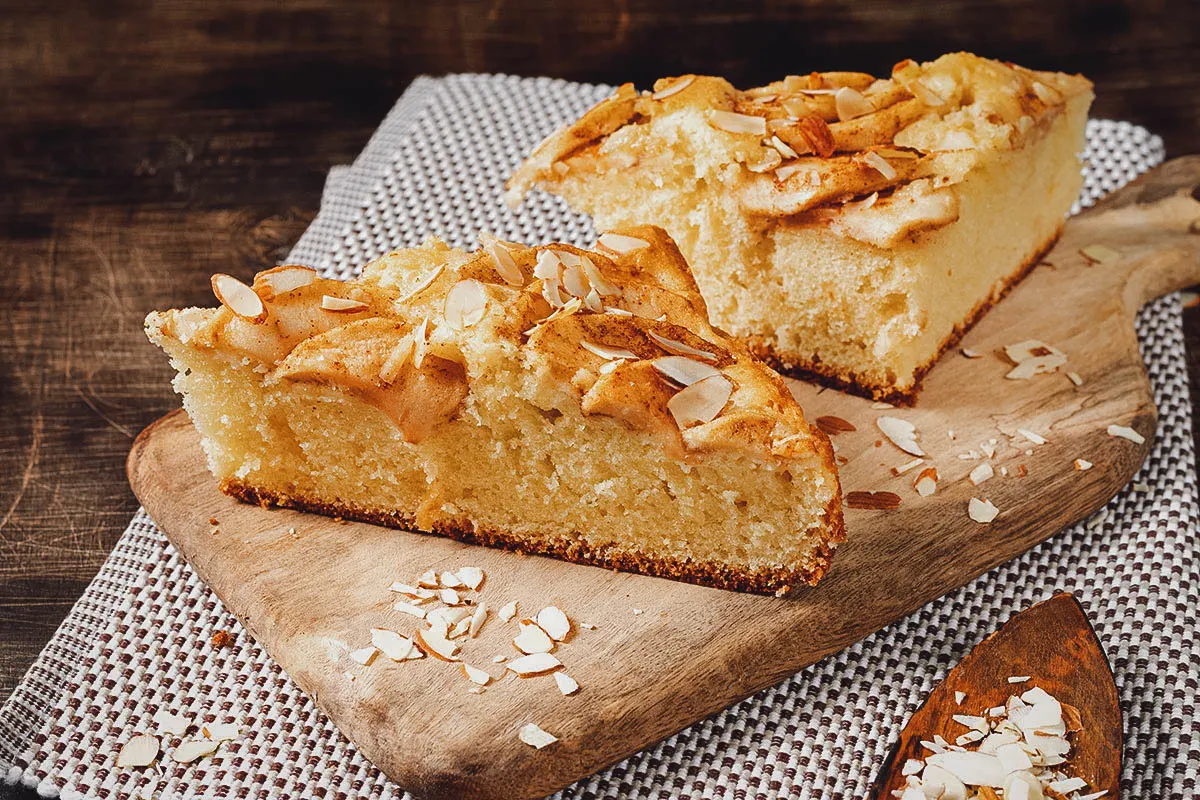
Photo by mila_lz
19. Skolebolle
Skolebolle (or skolebrød) refers to a type of Norwegian sweet roll filled with custard and glazed with coconut shavings. Its name in Norwegian literally means “school bun” (or “school bread”). During World War II, parents had difficulty giving their children enough to eat so schools created skolebolle to help fatten them up. It’s been a Norwegian school tradition ever since.
Skolebolle is one of many different types of bolle, a Norwegian bun made with lightly sweetened yeasted dough and cardamom. They can be served plain or made with different ingredients like raisins (rosinbolle), chocolate (sjokoladebolle), cinnamon, custard, and jam.
RECIPE: Skoleboller
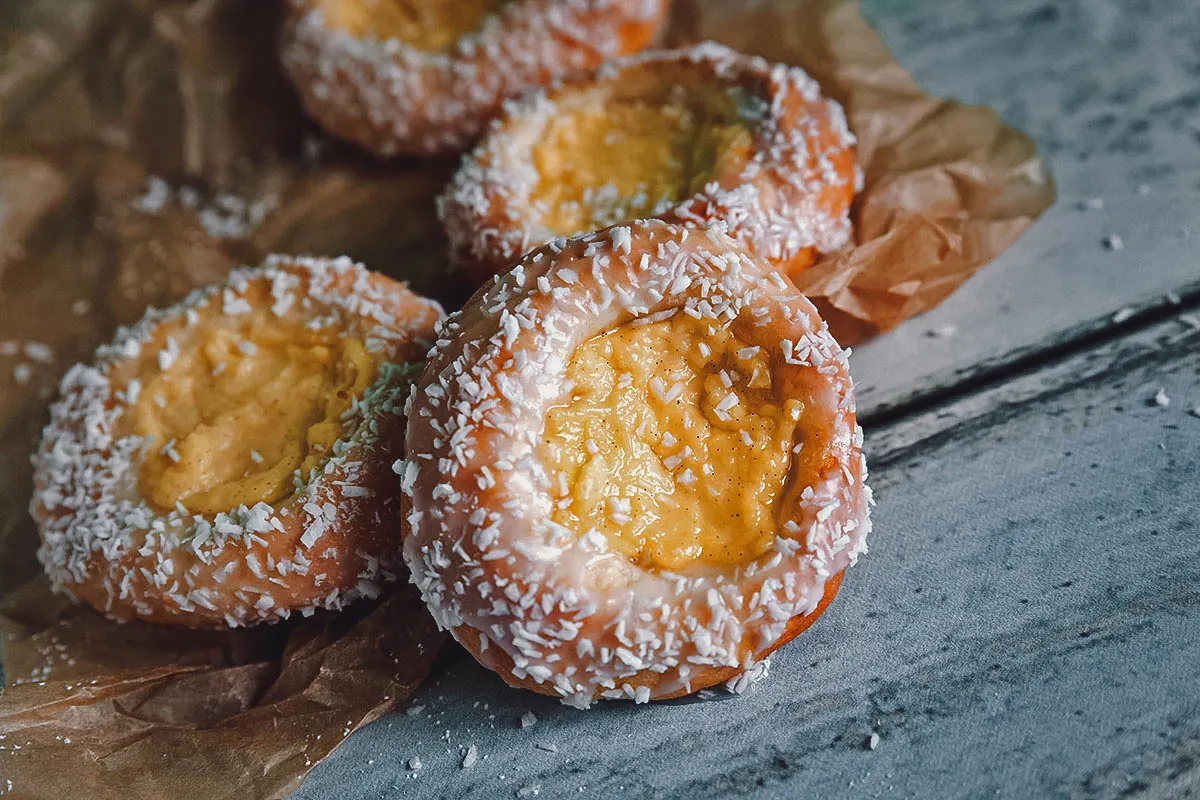
Photo by gorchichko
20. Julekake
Julekake (or julebrød) is a type of Norwegian Christmas bread. Popular during the holiday season in Norway, it’s spiced with cardamom and filled with candied fruits and raisins. Julekake is a type of kaffemat or Norwegian coffee food that’s often served with butter and fruit jam.
RECIPE: Julekake
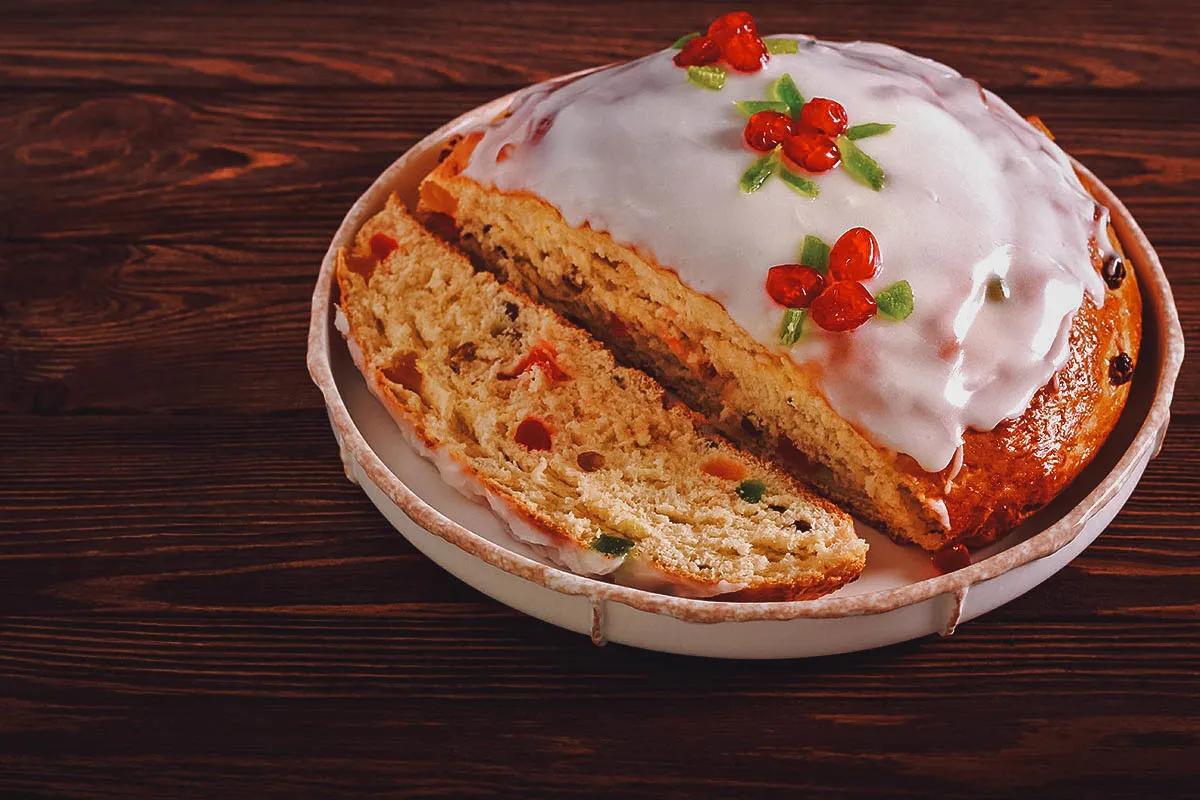
Photo by manyakotic
21. Krumkake
Krumkake is a Norwegian waffle cookie shaped like a cone. It’s similar to the Sicilian cannolo and made using a special two-sided iron griddle that imprints a decorative design on the waffle as it cooks. While still hot, it’s shaped into a cone using a conical rolling pin.
Krumkaker are traditionally a Norwegian Christmas treat. They can be eaten plain but they’re absolutely delicious when stuffed with sweet fillings like whipped cream and sugared cloudberries. They’re popular both in Norway and among Norwegian-Americans in the US.
RECIPE: Krumkake
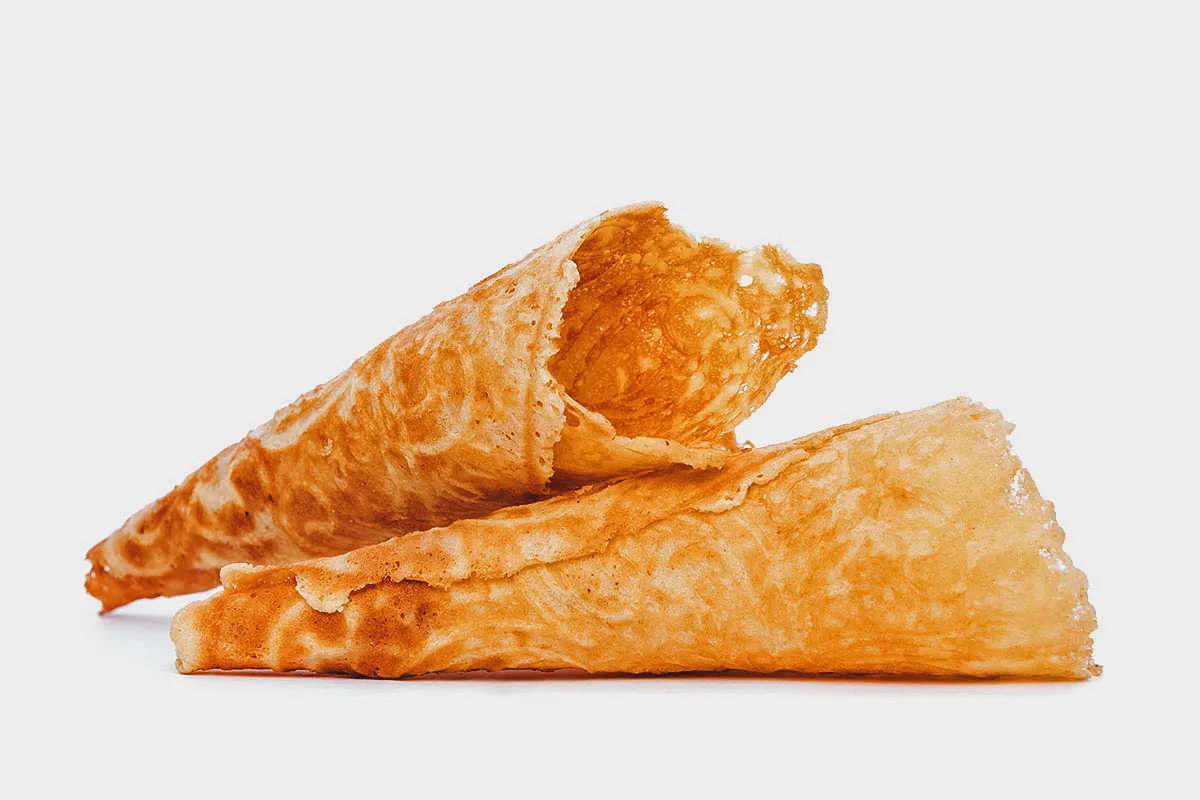
Photo by kjekol
22. Sandbakelse
Sandbakelse (or sandbakkels, sandkaker) are Norwegian Christmas cookies. They’re made with a crumbly dough that resembles sand, hence the name in Norwegian which translates to “sand cookies”.
Norwegian sandbakelse are formed by pressing the dough into fluted tins before baking. This creates a buttery cookie or tartlet that can be eaten as is or filled with sweet ingredients like jam or whipped cream.
RECIPE: Sandbakelse
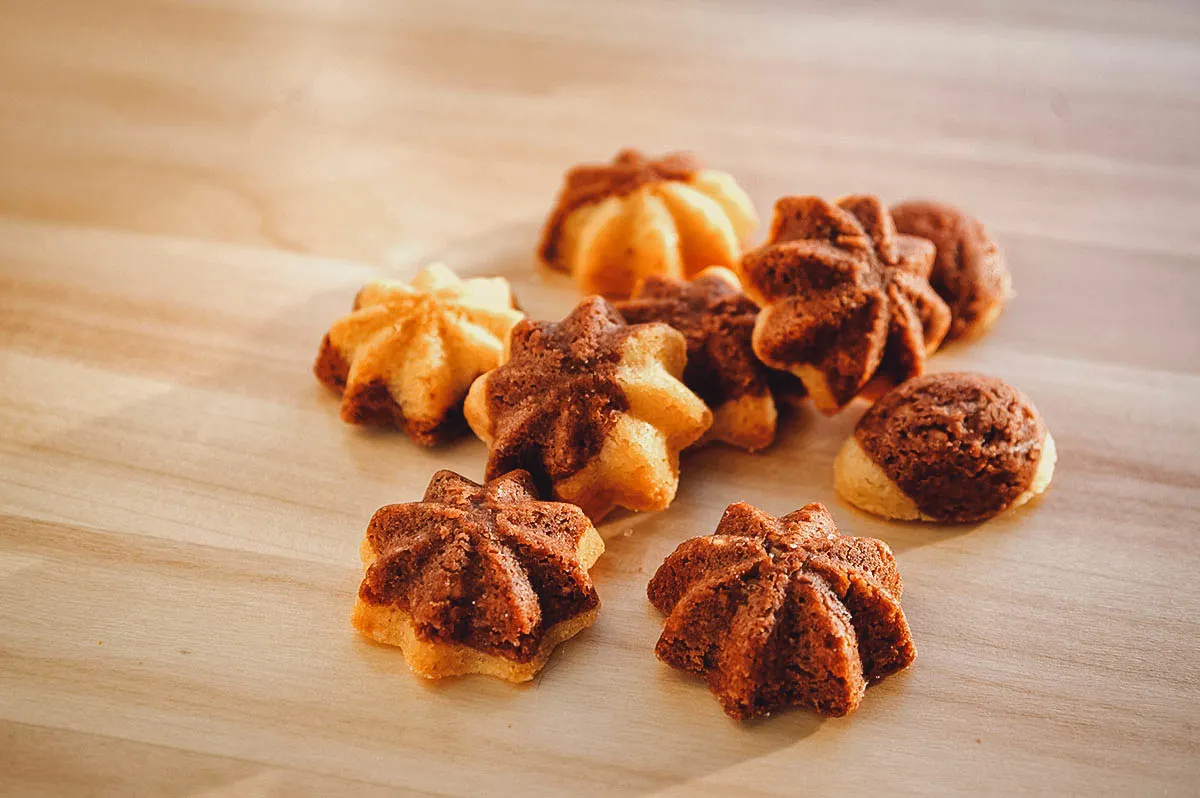
Photo by ivusakzkrabice
23. Rosettbakkels
Rosettbakkels are Norwegian rosette cookies known for their crispy texture and decorative patterns. Like krumkake and sandbakelse, they’re traditionally made around the Christmas season and are popular both in Norway and the US.
Rosettbakkels are made using a decorative iron mold with a long handle. The mold comes in festive shapes like snowflakes, stars, or Christmas trees. To make these Norwegian cookies, the mold is first heated in oil before being dipped and coated in batter. The batter-covered mold is then dipped into the hot oil where the batter detaches itself and finishes cooking.
The cookies are fried to a golden brown before being cooled and drizzled with sugar or honey.
RECIPE: Rosettbakkels
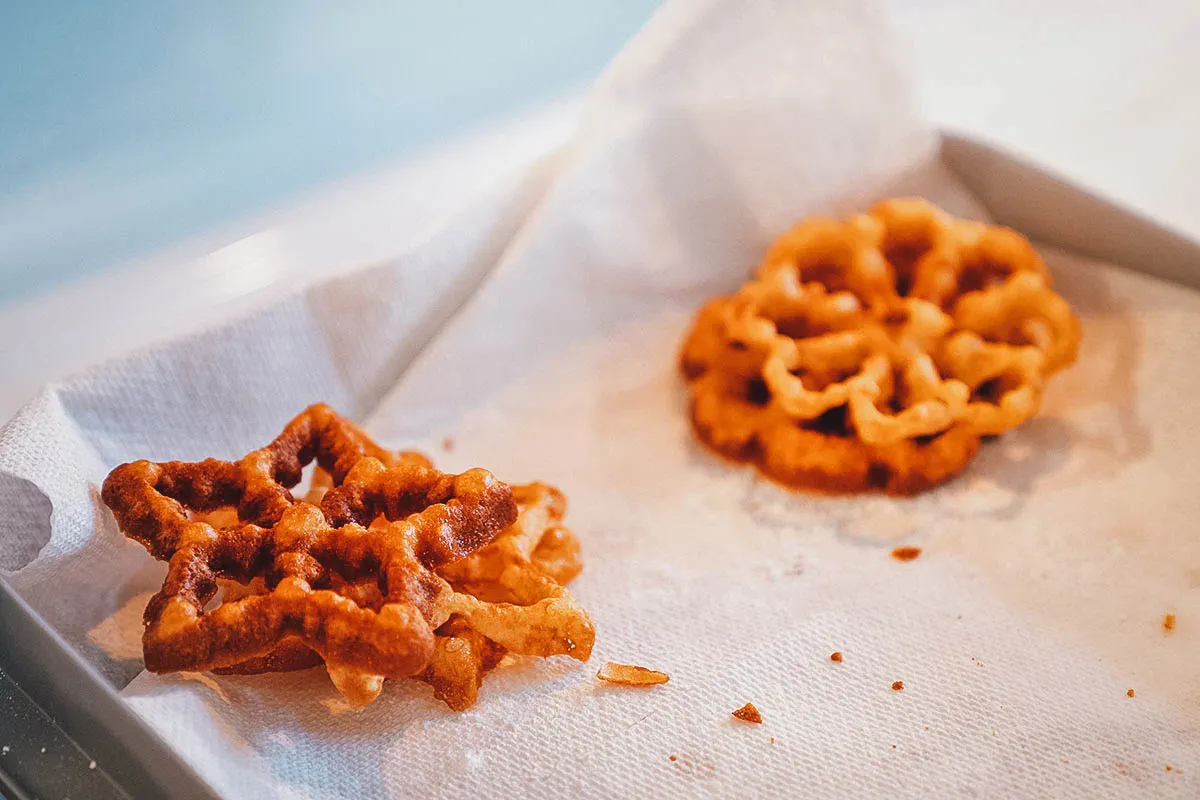
Photo by kmlPhoto
24. Kransekake
Kransekake (or tårnkake) is a traditional Norwegian confection that’s usually prepared on holidays and for special occasions like weddings and baptisms. Its name in Norwegian literally means “wreath cake” (or “tower cake”) and it consists of multiple concentric rings of decreasing sizes that are stacked to form a cone-shaped tower.
Kransekake cake rings are made with almonds, sugar, and egg whites. They’re hard to the touch but have a soft and chewy texture when eaten. Norwegian kransekake can often consist of eighteen or more layers that are held together with white icing.
To eat, the rings are separated and sliced into smaller pieces before serving. When served at Norwegian weddings, it’s a cultural tradition for the bride and groom to lift the topmost layer of the cake. How many rings come away with it is said to be the number of children the couple is destined to have.
Kranskekake is equally popular in Denmark where it’s known as kransekage.
RECIPE: Kransekake
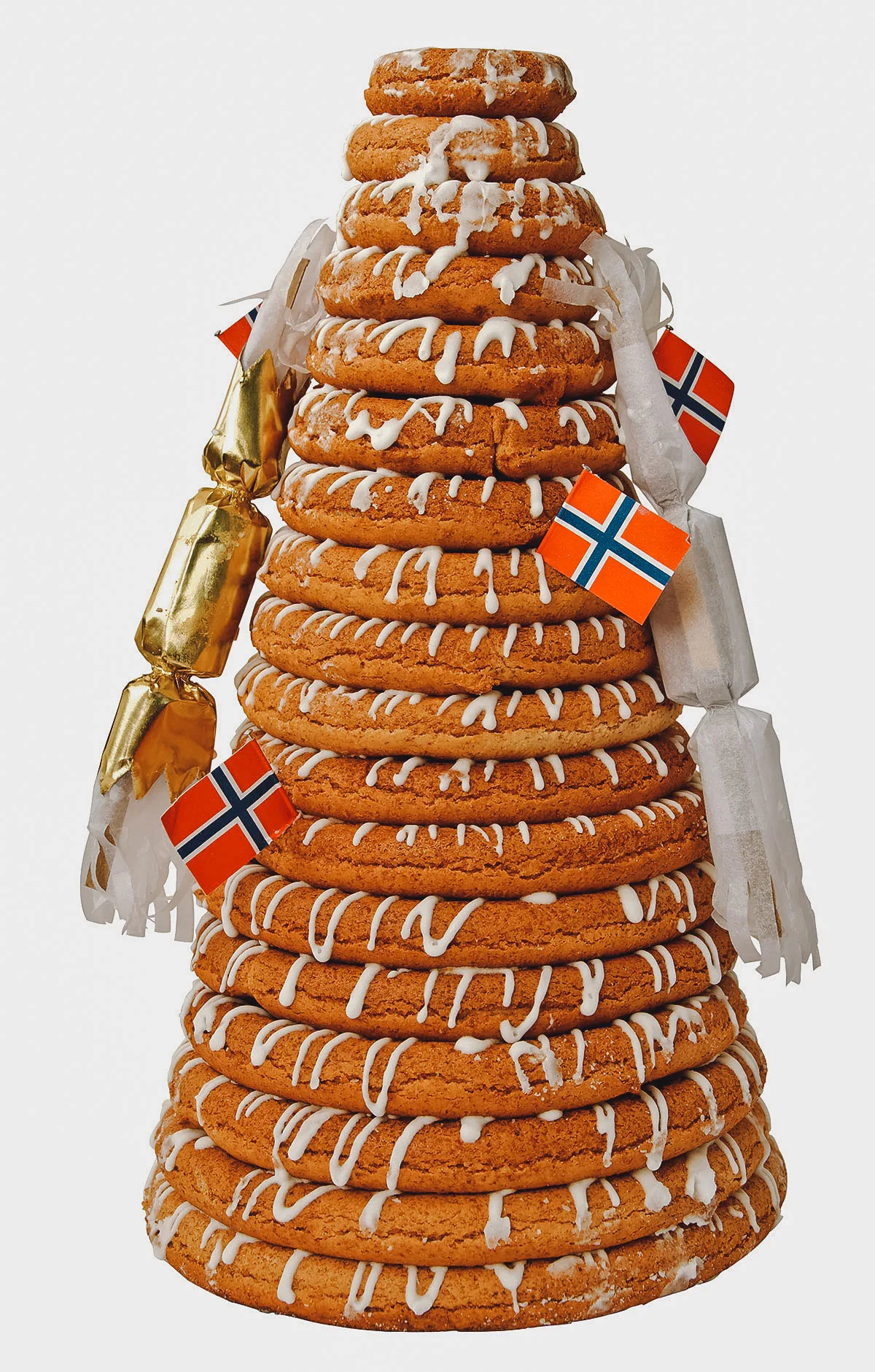
Photo by YAYImages
25. Cloudberries
These amber-colored berries are often referred to as the “gold of the Arctic”. They’re an extremely rare berry that grows only in the Arctic and subarctic regions of the north temperate zone. In Europe, that means mostly Norway, Sweden, and Finland.
Cloudberries thrive in the marshlands and boreal forests of Norway. They’re difficult to farm in large quantities and are available only from July till August, making them one of the rarest and most sought-after berries in Norway. At about EUR 20 per kilo, they’re also the most expensive.
Because of their rarity, your best chance of trying cloudberries in Norway is to buy them from someone who grows them or to pick them yourself. Finnmark in northern Norway is one of the best places to pick cloudberries. You can eat them on site but you’ll need a permit if you’d like to take them with you.
Cloudberries are a rich source of Vitamins A and E, and they can contain up to four times as much Vitamin C as oranges. They can be turned into jams or used in Norwegian desserts, cakes, sauces, and liquor. When eaten fresh, they’re soft and juicy with a distinct sweet/tart flavor.
RECIPE: Cloudberry cream
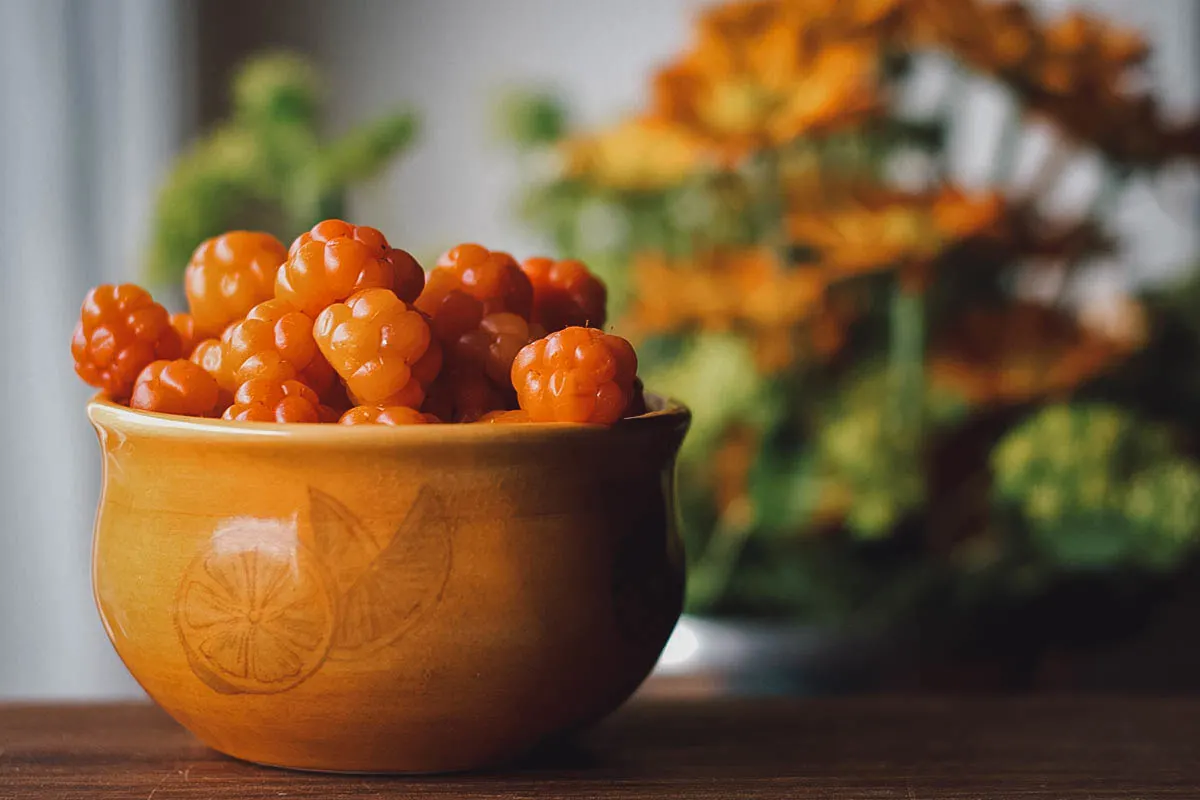
Photo by Mari-Roshfor
NORWEGIAN FOOD TOURS
Needless to say, no one knows Norwegian food better than a local, so what better way to experience the best of Norwegian cuisine than by going on a food tour? A knowledgeable local will guide you to the best Norwegian restaurants and markets so all you have to do is follow and eat. Check out Get Your Guide for a list of Norwegian food tours in Oslo and other cities throughout Norway.
FINAL THOUGHTS ON NORWEGIAN FOOD
Thanks to globalization, it’s just as easy to get sushi in Oslo as it is to get pizza in Tokyo. But if you’re a Traveleater with a keen interest in traditional Norwegian food, then this list of 25 Norwegian dishes should give you a lot to look forward to on your next trip to Norway.
Disclosure
Some of the links in this Norwegian food guide are affiliate links, meaning we’ll earn a small commission if you make a booking at no extra cost to you. As always, we only recommend products and services that we use ourselves and firmly believe in. We really appreciate your support as it helps us make more of these free travel and food guides. Thank you!
Cover photo by duskbabe. Stock images via Depositphotos.


Jennifer Edwards
Monday 27th of December 2021
Unfortunately you're wrong on the lefse in America. My family still makes flour lefse. It's very annoying that every thinks only potato lefse exists in the US. I'm 3rd generation out of Norway, my grandfather being 1st and I've never consumed potato lefse in my life.
JB & Renée
Thursday 30th of December 2021
Happy to hear that flour lefse is still consumed in America Jennifer. I'll be sure to correct that in the next article update. Thanks for letting us know!
martin
Wednesday 23rd of June 2021
That's interesting. I had absolutely no clue what Norway's food was like... now I do! Previously, I had only heard of the infamous lutfisk. Now I have some idea of what the food is like.
JB & Renée
Thursday 24th of June 2021
Thanks Martin!